Microsoft NHL-9 GSM 900/1800/1900 Cellular Telephone w/Bluetooth User Manual Manual 2
Microsoft Mobile Oy GSM 900/1800/1900 Cellular Telephone w/Bluetooth Manual 2
Contents
- 1. Manual 1
- 2. Manual 2
Manual 2
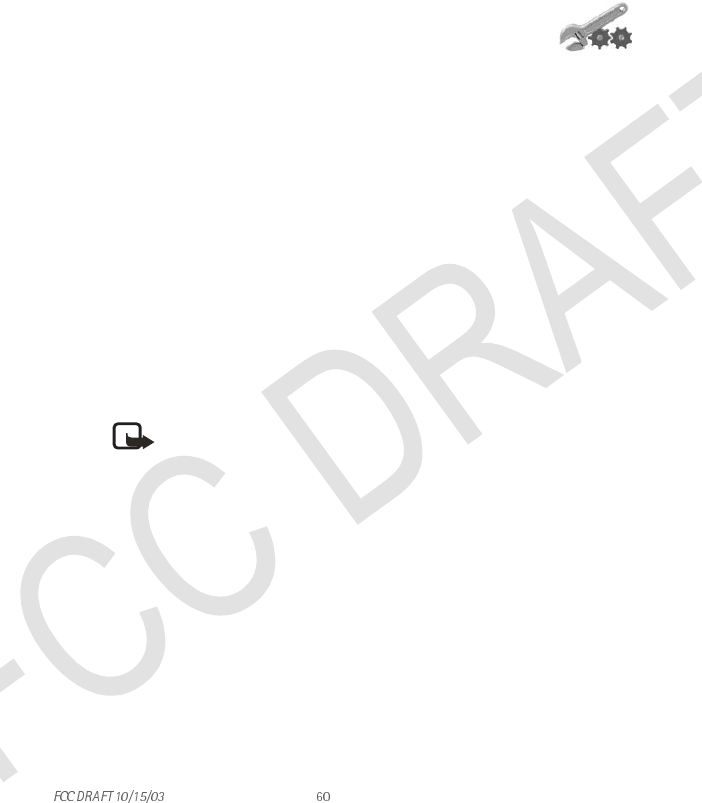
Copyright © Nokia 2003
10 Settings
•PROFILES
Your phone has a group of profiles that allow you to personalize the tone settings of your
phone and to activate a profile for different events and environments. Available profiles are
General, Silent, Meeting, Outdoor, My style 1 and My style 2.
Select Menu > Settings > Profiles and select a profile. Choose from the following options:
• To activate the selected profile, select Activate.
• To activate the profile for a certain amount of time up to 24 hours, select Timed and
set the end time. When the timed profile expires, the previous profile that was not
timed, becomes active.
• To personalize the profile, select Personalize. Select the setting that you want to
change and make the changes.
The settings can also be changed in the Tone settings menu, see “Tone settings” on
page 61 on.
To rename a profile, select Profile name. The General profile cannot be renamed.
• To change your presence status, select My presence. The menu is available if you have
set Synchronize with profiles to On, see “My presence” on page 54. Select My
availability to change your availability status and My presence message to edit your
status message.
Note: To quickly change the profile in the standby mode, press the Power key,
scroll to the profile that you want to activate and press Select.
• CHAT AND MY PRESENCE SETTINGS
For the settings required for IM, contact your network operator or service provider. To
receive the IM and presence settings over the air, see “Over-the-air settings service” on
page 22.
KEYING IN THE SETTINGS MANUALLY
1Select Menu > Settings > Chat and my presence settings > Active chat and
presence settings.
2Scroll to the set you would like to activate and select Activate.
You need to activate the connection set where you want to save the settings. A
connection set is a collection of settings required to make a connection to the chat and
presence services.
3Select Edit active chat and presence sett..
6820.ENv1_9310322.book Page 60 Wednesday, October 15, 2003 1:43 PM

Nokia User Guide-FCC DRAFT 10/16/03 Copyright © Nokia 2003
Settings
Select each of the settings one by one and key in all the required information that you
have received from your network operator or service provider.
Note: The connection settings are in the Connection settings menu.
• TONE SETTINGS
You can find the same settings in the Profiles menu. The settings you make change the
settings in the active profile
Select Menu > Settings > Tone settings, and select:
•Incoming call alert and select how the phone notifies you of an incoming voice call.
•Ringing tone to select a tone for incoming voice calls. To select ringing tones that have
been saved in the Gallery, select Open gallery from the ringing tone list.
•Ringing volume to set the tone level for incoming voice calls and incoming messages.
Note: If you download a ringing tone or receive one using OTA, you can save
it in the Gallery.
•Vibrating alert to set the phone to vibrate for incoming voice calls and incoming
messages. The vibrating alert does not work when the phone is connected to a charger,
a desktop stand, or a car kit.
•Message alert tone to set the alert tone for incoming messages.
•Keypad tones to adjust the tone level of keypad.
•Warning tones to set the phone to sound tones, for example when the battery is
running out of power.
•Alert for to set the phone to ring only on calls from phone numbers that belong to a
selected caller group. Scroll to the caller group that you want or All calls and select
Mark.
• DISPLAY SETTINGS
Select Menu > Settings > Display settings, and select
•Wallpaper to set the phone to display a background image, known as wallpaper, when
the phone is in the standby mode. Some images are provided in the Gallery menu. You
can also receive images, for example through a multimedia message, or use PC Suite
to transfer them from your PC and then save them in Gallery. Your phone supports
JPEG, GIF, WBMP, BMP and PNG formats, but not necessarily all variations of these
formats. Select:
• Select image to open an image folder. Scroll to the desired image you want to set
as wallpaper, select Options > Set as wallpaper.
•On or Off to activate/deactivate the wallpaper. (The wallpaper is not displayed
6820.ENv1_9310322.book Page 61 Wednesday, October 15, 2003 1:43 PM

Copyright © Nokia 2003
when the phone activates the screen saver.)
•Color schemes to change the color of some display components, for example icons and
signal bars.
•Menu view to select how the main menu items are displayed on the phone. Select List
or Grid.
•Operator logo to set the phone to show or hide the operator logo. If you have not saved
any operator logos, the Operator logo menu is dimmed.
The operator logo is not displayed when the phone activates the screen saver.
•Screen saver timeout and select the timeout after which the screen saver will be
activated. The length of the timeout can vary from 5 seconds to 60 minutes.
The digital clock screen saver is used for power saving in the standby mode. It is
activated when no function of the phone has been used for a certain length of time
while the keyboard is closed. Press any key to deactivate the screen saver or open the
keyboard. The screen saver is also deactivated when the phone is out of the network
coverage area. The screen saver overrides graphics and texts on the display in the
standby mode.
•Display brightness to change the brightness level of the phone display. Move the
joystick to the left to decrease and to the right to increase the brightness level, and
select OK to accept it
• TIME AND DATE SETTINGS
Select Menu > Settings > Time and date settings, and select:
•Clock > Show clock or Hide clock to show or hide the time on the top right of the
display in the standby mode. Select Set the time to adjust the clock to the correct time,
and Time format to select 12-hour or 24-hour time format.
The clock is also used for the functions Messages, Call register, Alarm clock, timed
Profiles, Calendar, Notes, and screen saver for example.
If the battery is removed from the phone for a long time, you may need to reset the
time.
•Date > Show date or Hide date to show or hide the date on the display in the standby
mode. Select Set the date to adjust the date. You can also select the date format.
•Auto-update of date & time (network service) to set the phone to automatically
update the time and date according to the current time zone, select On. To set the
phone to ask for confirmation before the update, select Confirm first.
The automatic update of date and time does not change the time you have set for the
alarm clock, calendar or the alarm notes. They are in local time. Updating may cause
some alarms that you have set to expire.
6820.ENv1_9310322.book Page 62 Wednesday, October 15, 2003 1:43 PM
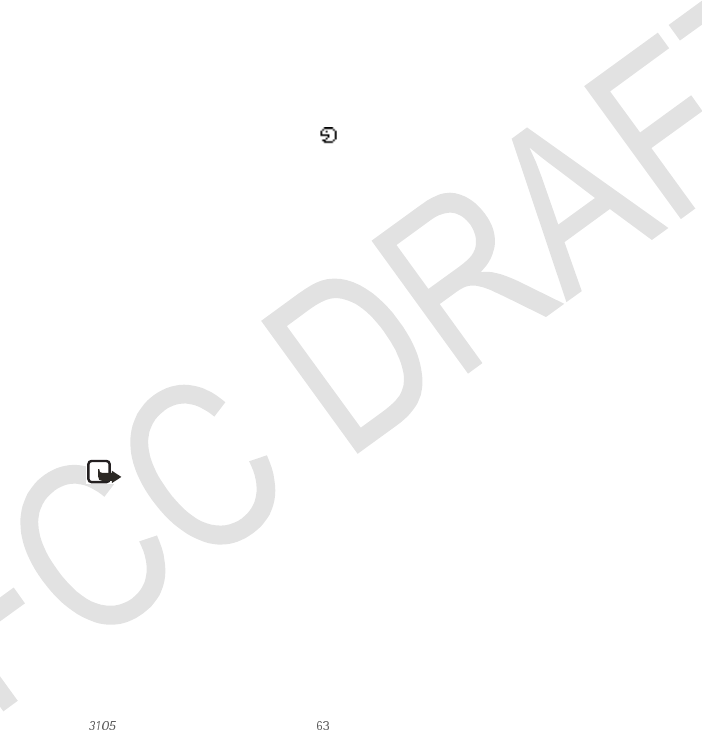
Nokia User Guide-FCC DRAFT 10/16/03 Copyright © Nokia 2003
Settings
• PERSONAL SHORTCUTS
You can select the function for the Right selection key displayed in the standby mode.
You have also a list of phone functions which can be activated by saying a voice tag. Up to
five voice tags for the voice commands can be added.
Select Menu > Settings > Personal shortcuts, and select:
•Right selection key to view the list of available functions for the Right selection key.
Scroll to the function that you want and select it.
•Voice commands and select the command folder you want, scroll to the command to
which you want to add a voice tag. Select Options > Add command. If the command
already has a voice tag, the icon is shown. For adding and activating a voice
command, see “Voice dial” on page 57.
During a call or when an application using the EGPRS connection is sending or
receiving data, you cannot activate or add a voice command.
• CONNECTIVITY
You can connect the phone to a compatible device using an IR or Bluetooth connection. You
can also define the settings for EGPRS dial-up connections. Bluetooth connections and
infrared connections cannot be active at the same time.
Bluetooth technology(technical reviewers-plse check
profiles over carefully)
The phone supports Bluetooth wireless technology which allows you to connect the phone
to a compatible Bluetooth device within 10 meters. The Bluetooth connection can be
subject to interference from obstructions such as walls or other electronic devices.
Note: There may be restrictions on using Bluetooth devices in some locations.
Check with your local authorities or service provider.
The Nokia 6820 phone is designed to be compliant with and adapt to Bluetooth
Specification 1.1. Compatibility between the phone and other products with Bluetooth
wireless technology depends also on the profiles and protocols used by the devices. The
current profiles supported by the Nokia 6820 are:
• SAP (Sim Access Profile)
• OPP (Object Push Profile) as a client and server
• FTP (File Transfer Profile) as a server
• DUN (Dial-up Networking Profile) as a gateway
• HSP (Headset Profile)
• HFP (Hands-free Profile) as an audio gateway
• SDP (Service Discovery Profile)
6820.ENv1_9310322.book Page 63 Wednesday, October 15, 2003 1:43 PM
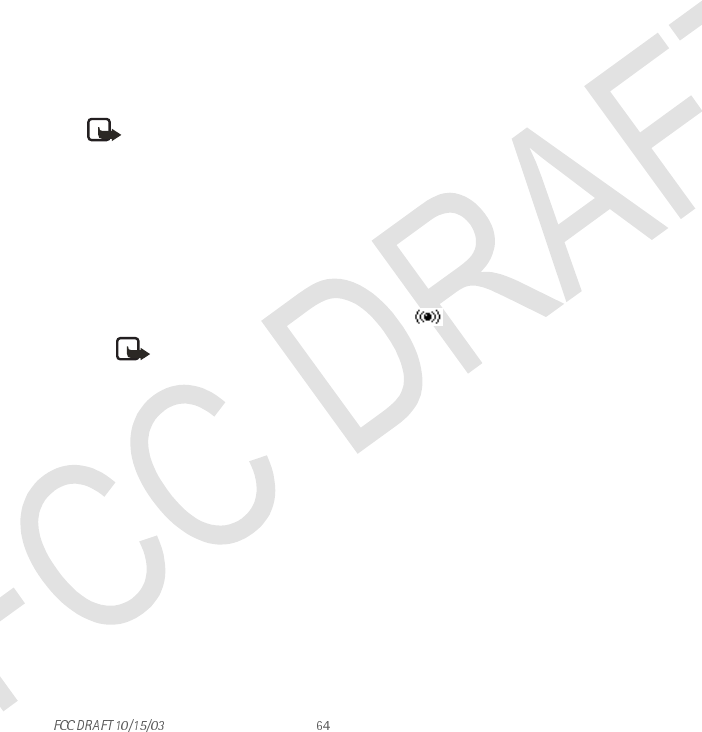
Copyright © Nokia 2003
• GAP (Generic Access Profile)
• SPP (Serial Port Profile) with the PC connectivity software
• GOEP (Generic Access Exchange Profile)
When a profile is active, the profile is shown on the phone display, such as Remote SIM, to
indicate that the phone is disconnected from the GSM network, thereby deactivating all
phone functions.
For compatibility between your phone and another Bluetooth device, consult the
documentation for the device and your Nokia dealer. In some countries, there may be
restrictions on using Bluetooth devices. Check with your local authorities.
Note: Using Bluetooth features, or allowing them to run in the background while
using other features, increases the demand on battery power and reduces the
battery life.
Set up a Bluetooth connection
When you activate the Bluetooth application for the first time, you are asked to provide a
Bluetooth name for your phone. This is the name that will be seen by other Bluetooth users.
Use the following steps to activate your Bluetooth connection.
1Select Menu > Settings > Connectivity > Bluetooth.
2Select Bluetooth > On.
The active Bluetooth connection is indicated by at the top of the display.
Note: If you do not plan to use the Bluetooth feature for an extended time
period, deactivate it to save power.
3Select Search for audio enhancements to search for compatible Bluetooth devices.
4Select the device that you want to connect to the phone.
5Enter the Bluetooth passcode of the device to associate (or pair) and connect the
device. (You only need to give this passcode when you connect to the device for the
first time.)
Set up Bluetooth name and visibility
Select Menu > Settings > Connectivity > Bluetooth > Bluetooth settings to define how
your phone is shown to other Bluetooth devices. Select:
•My phone’s visibility and Shown to all to show the phone to all other Bluetooth
devices or Hidden to show the phone only to the paired devices.
•My phone’s name to change the Bluetooth device name for your phone.
Start a Bluetooth connection
Select Menu > Settings > Connectivity > Bluetooth, and select:
•View active device to check which Bluetooth connection is currently active. If you
want to close the connection to the selected device, select Disconnect.
6820.ENv1_9310322.book Page 64 Wednesday, October 15, 2003 1:43 PM
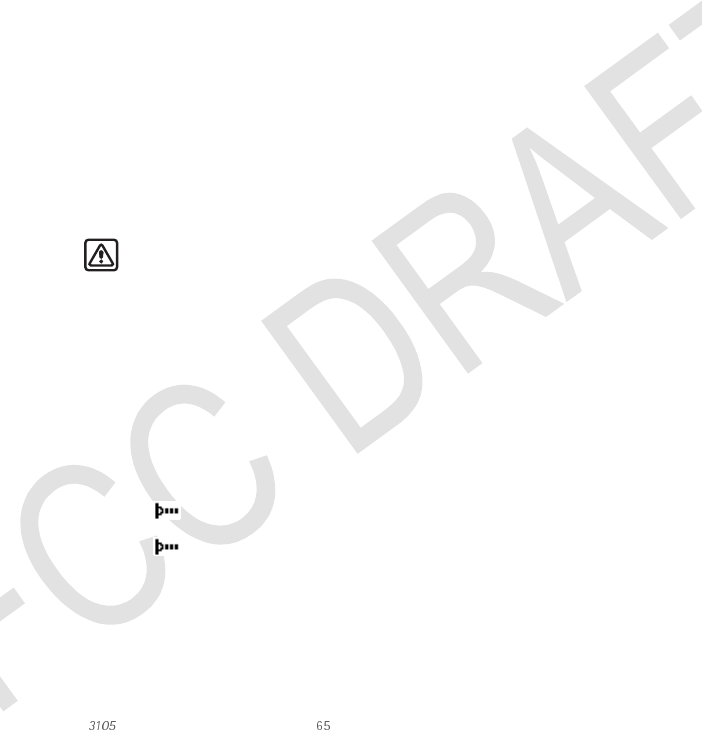
Nokia User Guide-FCC DRAFT 10/16/03 Copyright © Nokia 2003
Settings
• View paired devices to view a list of Bluetooth devices that are currently paired
with the phone. Scroll to the desired device. If you want to delete the pairing to
the device, select Delete.
Select Options to access some of the following functions. (This list may change depending
on the status of the device and the Bluetooth connection.)
Connect—to connect to the selected device.
Assign short name—to give a nickname (visible to you only) to the selected device.
Request conn. authorization—to set up authorization. Select No if you want the phone to
connect to the selected device automatically, or select Yes if you want the phone to ask for
your permission first.
Infrared
The phone has an IR port that you can use for connecting your phone to another IrDA
compliant device. You can send or receive data such as business cards and calendar notes
to or from a compatible phone or data device, such as a computer.
Warning:Do not point the IR (infrared) beam at anyone's eye or allow it to interfere
with other IR devices. This device is a Class 1 Laser product.
Send and receive data using IR
• Ensure that the IR ports of the sending and receiving devices are pointing at each other
and that there are no obstructions between the devices. The preferable distance
between the two devices in an infrared connection should be one meter at most.
• To activate the IR port of your phone, select Menu > Settings > Connectivity >
Infrared.
• The user of the sending phone selects the desired IR function to start data transfer.
If the data transfer is not started within two minutes after the activation of the IR port, the
connection is cancelled and has to be started again.
IR connection icon
•When appears continuously, the IR connection has been activated and your
phone is ready to send or receive data using its IR port.
•When blinks, your phone is trying to connect to the other device or a connection
has been lost.
The IR connection deactivates automatically.
EGPRS
GPRS (general packet radio service) is a network service that allows mobile phones to be
used for sending and receiving data over an Internet Protocol (IP)-based network GPRS is a
data bearer that enables wireless access to data networks as the Internet.
6820.ENv1_9310322.book Page 65 Wednesday, October 15, 2003 1:43 PM
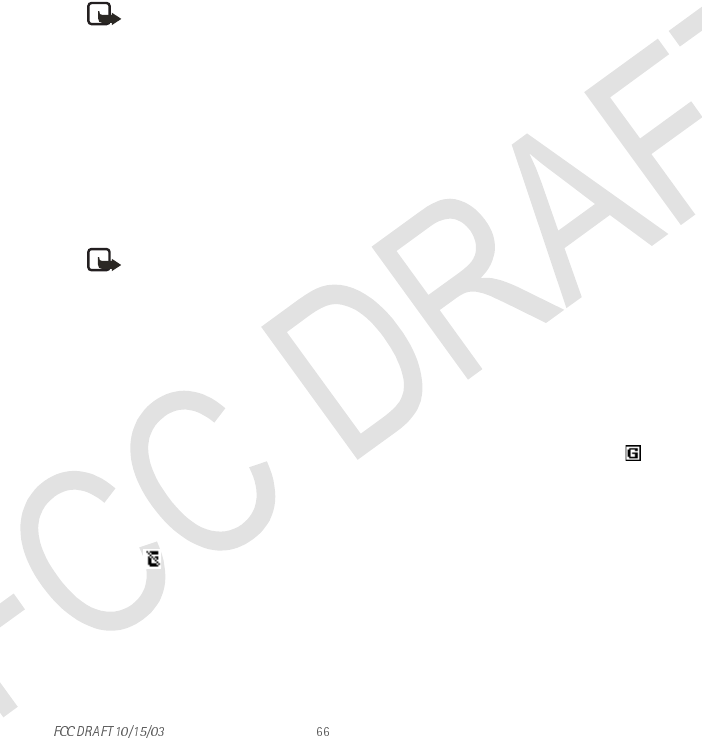
Copyright © Nokia 2003
EGPRS (enhanced GPRS), also known as EDGE (enhanced data rates for global evolution) is
similar to GPRS but the connection is faster. For more information on availability of EGPRS
and data transfer speed, contact your network operator or service provider.
Note: The Nokia 6820 is 3GPP GSM Release 99 terminal supporting EGPRS service,
and is designed to support also Release 97 GPRS networks. However, proper
functionality in all Release 97 GPRS networks cannot be guaranteed. For more
information, contact your service provider or local Nokia dealer.
The applications that may use EGPRS are multimedia, chat and text messaging, browsing
sessions, e-mail, remote SyncML, Java application downloading and the PC dial-up (for
example, Internet and e-mail).
Before you can use EGPRS technology:
• Contact your network operator or service provider for availability and subscription to
the EGPRS service.
• Save the EGPRS settings for each of the applications used over EGPRS.
For information on pricing, contact your network operator or service provider.
Note: When you select GPRS as a data bearer, the phone uses EGPRS instead of
GPRS, if this is available in the network. You cannot select between EGPRS and
GPRS but for some applications you may be able to select either GPRS or GSM data
(CSD, Circuit Switched Data).
EGPRS CONNECTION
Your phone supports three simultaneous EGPRS connections. For example, you can at the
same time browse XHTML pages, receive multimedia messages and have an ongoing PC
dial-up connection.
Select Menu > Settings > Connectivity > GPRS > GPRS connection.
•Select Always online to set the phone to automatically register to an EGPRS network
when you switch the phone on. When the GPRS connection is established, the icon
is shown on the top left of the display
When you start an application using EGPRS, the connection between the phone and
the network is established, and data transfer is possible. When you end the application,
the EGPRS connection is ended but the registration with the EGPRS network remains.
If you receive a call or a text message, or make a call during a GPRS connection, the
icon will be shown on the top right of the display to indicate that the EGPRS
connection has been suspended (on hold).
The GPRS and EGPRS connection are indicated by the same icons.
• If you select When needed, the EGPRS registration and connection are established
when required by an application using GPRS and closed when you end the application.
6820.ENv1_9310322.book Page 66 Wednesday, October 15, 2003 1:43 PM

Nokia User Guide-FCC DRAFT 10/16/03 Copyright © Nokia 2003
Settings
• EGPRS MODEM SETTINGS
You can connect the phone to a compatible PC using infrared, Bluetooth or a data cable
connection and use the phone as a modem to enable EGPRS connectivity from the PC.
Select Menu > Settings > Connectivity > GPRS > GPRS modem settings. Select Active
access point to activate the desired access point. Select Edit active access point to change
the access point settings.
•Select Alias for access point. Key in the name that you would like for the activated
access point and select OK.
•Select GPRS access point.. Key in the Access Point Name (APN) to establish a
connection to an EGPRS network. Contact your network operator for the APN.
You can also set the (E) GPRS dial-up service settings (Access Point Name) on your PC using
the Nokia Modem Options software. See “PC Suite” on page 96. If you have set the settings
on both your PC and on your phone, the settings for the PC are used.
• CALL SETTINGS
Select Menu > Settings > More settings > Call settings, and select
•Call divert (network service) to direct your incoming calls, for example to your voice
mailbox number. Divert options that are not supported by your SIM card or your
network operator may not be shown. Contact your service provider for details.
For example, select Divert if busy to divert your voice calls when your number is busy
or when you reject an incoming call.
To set the divert setting to on, select Activate and then select the timeout after which
the call is diverted, if this is available for the call divert option. To set the call divert to
off, select Cancel. To check whether the call divert is activated or not, select Check
status if this is available for the divert option. Several divert options may be active at
the same time.
To see the divert icons in the standby mode, see “Icons in the standby mode” on
page 19.
•Anykey answer and select On and you can answer an incoming call by briefly pressing
any key, except the Power key, Left selection key, Right selection key, and End key.
•Automatic redial and select On and your phone will make a maximum of ten attempts
to connect a call after an unsuccessful call attempt.
•Speed dialing and select On and the names and phone numbers that are assigned to
the speed dialing keys, from 2–9 with the keyboard closed, or the corresponding
number keys of the keyboard, can be dialed by pressing and holding the corresponding
number key.
•Call waiting and select Activate and the network will notify you of an incoming call
while you have a call in progress (network service). See “Call waiting” on page 24.
•Summary after call and select On and after each call the phone will briefly display the
6820.ENv1_9310322.book Page 67 Wednesday, October 15, 2003 1:43 PM
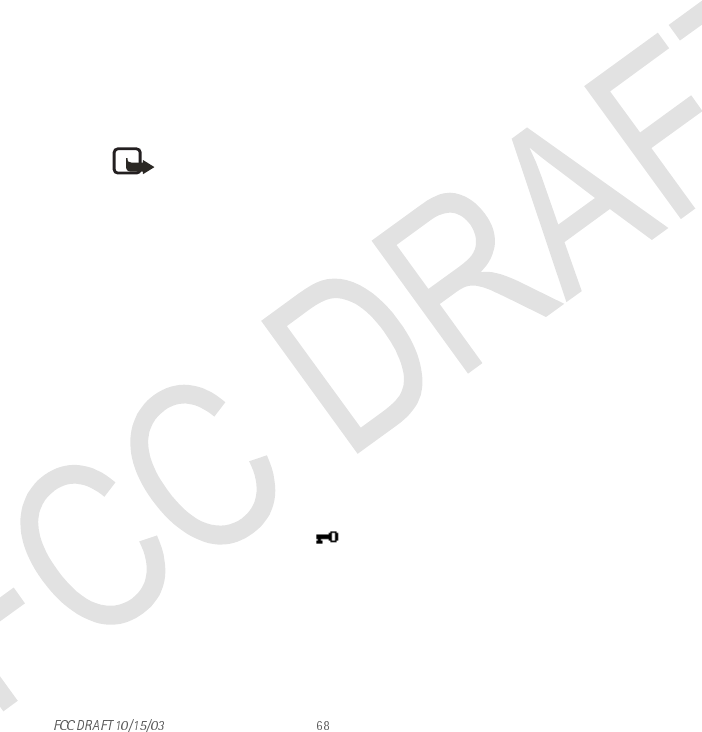
Copyright © Nokia 2003
duration and cost (network service) of the call.
•Send my caller identity and select Yes and your phone number will be displayed to the
person you are calling (network service). Select Set by network and the setting agreed
upon with your service provider is used.
•Line for outgoing calls (network service) to select the phone line 1 or 2 for making
calls, for example you can use line 1 for personal calls and line 2 for business calls. For
more information on availability, contact your network operator or service provider.
If you select Line 2 and have not subscribed to this network service, you will not be
able to make calls. However, calls on both lines can be answered regardless of the
selected line.
If supported by your SIM card, you can prevent the line selection by selecting the Lock
option.
Note: In the standby mode, you can switch from one line to the other by
pressing and holding the * key.
• PHONE SETTINGS
Select Menu > Settings > More settings > Phone settings, and select:
•Phone language to set the language for the display texts. If Automatic is selected, the
phone selects the language according to the information on the SIM card.
•Memory status to view the amount of free, used and total amount of memory for each
function. You may also find memory information in the menus of some functions, for
example in the Applications menu.
•Security keyguard to lock the keypad of the phone with a security code, see “Security
code (5 to 10 digits)” on page 70.
•Key in the security code and select OK.
•To set the security keyguard, select On. The keypad lock remains active, if you open
the keyboard.
To activate the security keyguard, select Menu and the * key within 1.5 s., when
the keyboard is closed. To deactivate the keyguard when the keyboard is open,
select Unlock > OK; then key in the security code. If the keyboard is closed, select
Unlock and the * key within 1.5 s.; then key in the security code.
When the keypad is locked, appears on top of the display. If you have
activated the security keyguard, it does not protect your phone data from PC Suite
access.
•Cell info display and select On to set the phone to indicate when it is used in a cellular
network that is based on Micro Cellular Network (MCN) technology.
•Welcome note and key in the note that you would like to be shown briefly when the
phone is switched on. To save the note, select Save.
•Network selection and Automatic and the phone automatically selects one of the
cellular networks available in your area.
6820.ENv1_9310322.book Page 68 Wednesday, October 15, 2003 1:43 PM

Nokia User Guide-FCC DRAFT 10/16/03 Copyright © Nokia 2003
Settings
If you select Manual, you can select a network that has a roaming agreement with your
home network operator. If No network access is displayed, you must select another
network. The phone stays in manual mode until the automatic mode is selected or
another SIM card is inserted into the phone.
•Confirm SIM service actions. See “SIM services” on page 95.
•Help text activation to set the phone to show the help topics.
•Start-up tone to set the phone to play a start-up tone when it is switched on.
• ENHANCEMENT SETTINGS
The enhancement settings menu is only shown if the phone is or has been connected to
some mobile enhancements (accessories), for example to chargers or hands-free units.
Select Menu > Settings > Enhancement settings. Then select an appropriate enhancement
from a list, if the corresponding enhancement is or has been connected to the phone. Select:
• Default profile to automatically activate the desired profile when you connect to the
selected enhancement. You can select another profile while the enhancement is
connected.
•Automatic answer to set the phone to automatically answer an incoming call after five
seconds. If the Incoming call alert is set to Beep once or Off, automatic answer will
not be used.
•Lights to set the lights permanently to On. Select Automatic to set the lights on for 15
seconds after a keypress. The Lights option is available only when Handsfree is
selected.
• When the phone is connected to the full car kit, select Ignition detector and On to
automatically switch off the phone approximately 20 seconds after you have switched
off the ignition.
•For Text phone, select Use text phone and select Yes to use the text phone settings
instead of headset or loopset settings.
• SECURITY SETTINGS
To work with security settings, select Menu > Settings > More settings > Security
settings, and select the setting you would like to modify.
Note: When security features that restrict calls are in use (call barring, closed user
group and fixed dialing), calls may be possible to certain emergency numbers in
some networks.
PIN code request
Select PIN code request to set the phone to ask for your PIN code every time the phone is
switched on. Some SIM cards do not allow the PIN code request to be turned off.
6820.ENv1_9310322.book Page 69 Wednesday, October 15, 2003 1:43 PM

Copyright © Nokia 2003
Call barring service (network service)
Select Call barring service (network service) to restrict incoming calls to and outgoing calls
from your phone. A barring password is required.
Fixed dialing
Select Fixed dialing to restrict your outgoing calls and text messages to selected phone
numbers if this function is supported by your SIM card. The PIN2 code is required.
When the fixed dialing is on, GPRS connections are not possible except while sending text
messages over a GPRS connection. In this case, the recipient’s phone number and the
message centre number must be included in the fixed dialing list.
Closed user group
Closed user group is a network service that specifies the group of people whom you can
call and who can call you. For more information, contact your network operator or service
provider.
Security level
Security level instructs the phone to ask for the security code whenever a new SIM card is
inserted into the phone.
Memory
Select Memory to set the phone to request the security code when the SIM card memory is
selected.
Access codes
Select Access codes to change the security code, PIN code, PIN2 code or barring password.
Codes can only include numbers from 0 to 9. Refer to the following items when changing
access codes.
SECURITY CODE (5 TO 10 DIGITS)
The security code protects your phone against unauthorized use. The preset code is 12345.
When you have changed the code, keep the new code secret and in a safe place separate
from your phone. To change the code, and to set the phone to request it, see “Security
settings” on page 69.
If you key in an incorrect security code five times in succession, the phone may display Code
error. Wait for five minutes and key in the code again.
6820.ENv1_9310322.book Page 70 Wednesday, October 15, 2003 1:43 PM

Nokia User Guide-FCC DRAFT 10/16/03 Copyright © Nokia 2003
Settings
PIN AND PIN2 CODES (4 TO 8 DIGITS), MODULE PIN, AND SIGNING PIN
The PIN (Personal Identification Number) code protects your SIM card against unauthorized
use. The PIN code is usually supplied with the SIM card. To set the phone to request the PIN
code each time the phone is switched on, see “Security settings” on page 69.
The PIN2 code may be supplied with the SIM card and is required to access some functions.
The module PIN is required to access the information in the security module. See “Security
module” on page 93. The module PIN is supplied with the SIM card if the SIM card has a
security module in it.
The signing PIN is required for the digital signature. See “Digital signature” on page 94. The
signing PIN is supplied with the SIM card if the SIM card has a security module in it.
If you key in an incorrect PIN code three times in succession, the phone may display PIM
blocked or PIN code blocked and ask you to key in the PUK code.
PUK AND PUK2 CODES (8 DIGITS)
The PUK (Personal Unblocking Key) code is required to change a blocked PIN code. The PUK2
code is required to change a blocked PIN2 code.
If the codes are not supplied with the SIM card, contact your network operator or service
provider.
BARRING PASSWORD (4 DIGITS)
The barring password is required when using the Call barring service. You can obtain the
password from your service provider.
WALLET CODE (4 TO 10 DIGITS)
The wallet code is required to access the wallet services. If you key in an incorrect wallet
code several times, the wallet application is blocked for five minutes. For further
information, see “Wallet” on page 79.
• RESTORE FACTORY SETTINGS
To reset the menu settings to their original values, select Menu > Settings > More
settings > Restore factory settings. Key in the security code and select OK.
Note: The data you have keyed in or downloaded, for example the names and
phone numbers saved in contacts, are not deleted.
6820.ENv1_9310322.book Page 71 Wednesday, October 15, 2003 1:43 PM

Copyright © Nokia 2003
11 Gallery
In the Gallery menu you can manage images, photos, recordings, tones
and video clips that you have, for example, received in multimedia
messages.
Your phone supports usage rights system to protect acquired content. A piece of content,
for example ringing tone, can be protected and associated with certain usage rules, for
example number of usage times and a certain usage period. The rules are defined in the
usage rights for the content which can be delivered either together with the content or
independently depending on the service provider. You may be able to update these rights.
Always check the delivery terms of any content and usage rights before acquiring them, as
they may be subject to a fee.
The gallery uses shared memory. For more information, see “Shared memory” on page 7.
1Select Menu > Gallery.
A list of folders is shown. Graphics, Photos, Video clips, Record and Tones, and are the
original folders on the phone.
2Scroll to the desired folder and select Open to view a list of files in the folder, or select
Options for one of the following options that may be available:
•Add folder, Delete folder, Move, Rename folder, Details, Type of view, Sort and
Gallery downloads
You cannot delete, rename or move the original folders on the phone.
• Type of view to select how the folders are displayed.
• Gallery downloads to download more images and tones. Select Image downloads
or Tone downloads. The list of available browser bookmarks is shown. Select More
bookmarks to access the list of bookmarks in the Services menu.
Select the appropriate bookmark to connect t the desired site. If the connection
fails, you may not be able to access the page from the service whose connection
settings are currently active. In this case, enter the Services menu and activate
another set of service settings. Try again to connect to the site.
For availability of different services, pricing and tariffs, contact your network
operator and/or the service provider. Download content only from the sources you
trust.
3If you opened a folder in step 2, select the file you want to view and select Open.
Or, select Options and use one of the following functions that may be available for the
selected file:
• Delete, Send, Move, Rename Set as wallpaper, Set as ring tone, Edit image,
Details, Type of view, Sort, Delete all, View in sequence, Play, Zoom, Mute audio
(Unmute audio), Set contrast.
•Send to send the selected file using MMS, a Bluetooth connection, or an IR
6820.ENv1_9310322.book Page 72 Wednesday, October 15, 2003 1:43 PM

Nokia User Guide-FCC DRAFT 10/16/03 Copyright © Nokia 2003
Gallery
connection.
• Delete all to delete all the files in the selected folder.
• Edit image to insert text, a frame or clip-art into the selected picture.
• View in sequence to view the files in the folder one by one.
•Play to listen to or to view a sound or image file that is contained in the message.
• Zoom to increase the size of the image that is contained in the message.
• Mute audio (Unmute audio) to mute (unmute) the sound file.
•Set contrast to adjust the contrast level of the image.
•Update rights to update the usage rights of the selected file. The option is only
shown if the rights update is supported by the file.
Copyright protections may prevent some images, ringing tones, and other content from
being copied, modified, transferred or forwarded.
6820.ENv1_9310322.book Page 73 Wednesday, October 15, 2003 1:43 PM
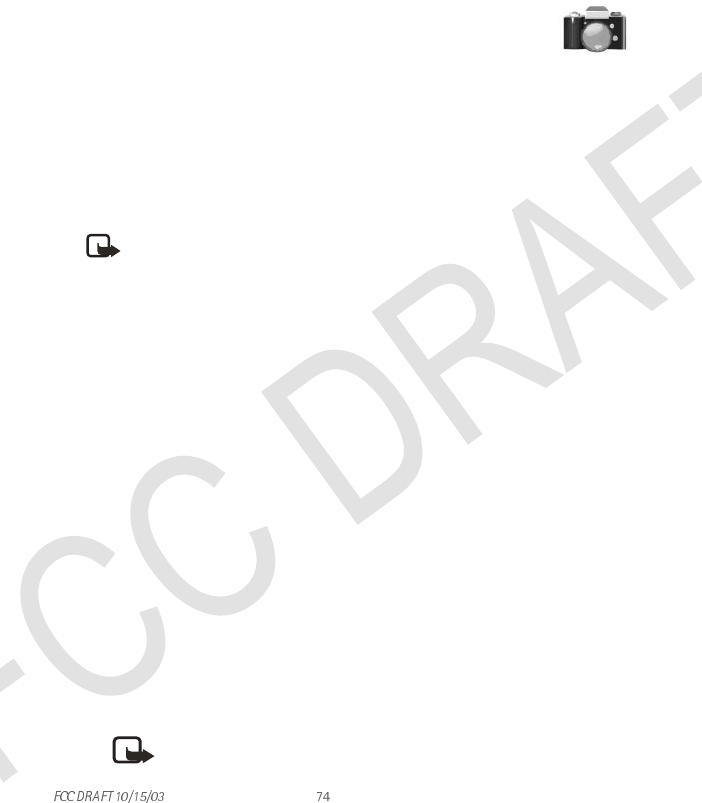
Copyright © Nokia 2003
12 Camera
You can take photos and record video clips with the built-in camera. The
camera lens is on the back of the phone, and the display of the phone
works as a viewfinder. The camera produces pictures in JPEG format and the video clips in
H.263 (SubQCIF) format. You cannot use the camera, if the keyboard is open.
The camera includes a self-timer if you want to be included in the photo. The timer allows
you 10 seconds before the camera takes the photo.
If there is not enough memory to take a new photo or record a video clip, you need to free
some by deleting old photos or other files from Gallery. The camera uses shared memory.
For more information, see “Shared memory” on page 7.
Note: Obey all local laws governing the taking of pictures.
• CAMERA SETTINGS
Use this procedure to choose your camera settings.
Select Menu > Camera > Settings. Choose the settings for the following:
•Image quality to define how much the photo file will be compressed when saving the
image. Select High, Normal or Basic. The High setting provides the best image quality
but takes more memory.
•Video clip length to select the length for video clips recorded with the camera. Select
Default if you intend to send the file as a multimedia message.
•Camera sounds to set the shutter sound and the self-timer tone to On or Off.
•Default title to define the prefix the camera should use to name the photo files. If you
select Automatic, the camera uses the prefix Image with an incremental number (such
as Image001, Image 002). If you select My title, you can key in a prefix for a series of
photos and the camera numbers the photo files for you. For example (PoolParty001,
PoolParty002).
• TAKE A PHOTO
1Select Menu > Camera and choose from the following:
• Standard photo—to take a basic photo using landscape orientation.
• Portrait photo—to take a photo using portrait orientation.
•Night mode—to take a photo when the lightning is dim.
Note: To quickly access the camera the standby mode (with standard photo
view), move the joystick up.
6820.ENv1_9310322.book Page 74 Wednesday, October 15, 2003 1:43 PM
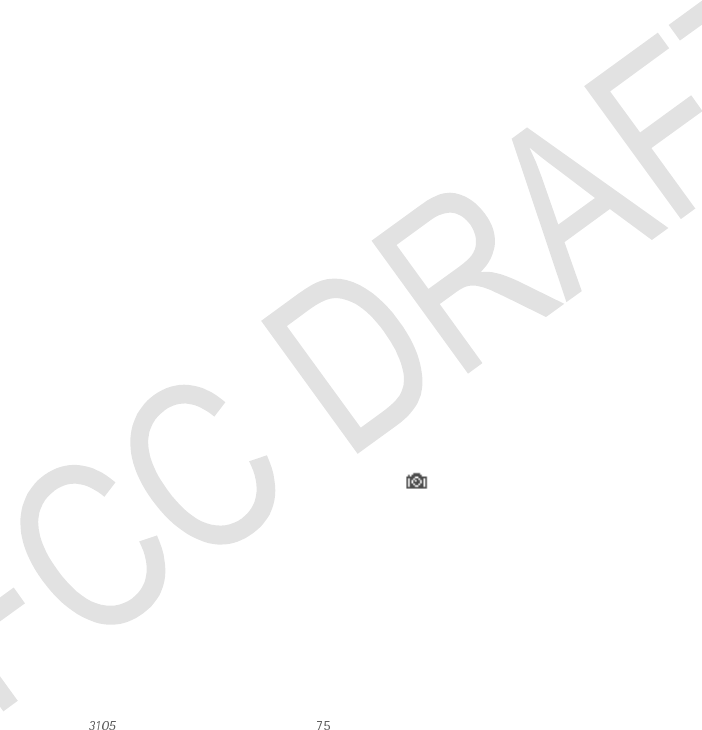
Nokia User Guide-FCC DRAFT 10/16/03 Copyright © Nokia 2003
Camera
The image appears on the display, and you can use the display as a viewfinder.
2Select Capture.
The phone saves the photo in the Photos folder of the Gallery menu. The saved photo
appears on the display.
3Select Back to take another photo, or select Options and select from the following:
• Zoom—to enlarge the view. Use the joystick to reposition the picture in the
viewfinder window.
•Send—to send the photo using MMS, IR or Bluetooth technology.
•Rename—to change the name of the photo.
• Open Gallery—to view the folders in the Gallery menu.
•Set contrast—to adjust the contrast for the photo.
• Set as wallpaper—to save the photo as background wallpaper on your phone.
•Details—to see the name, size, resolution, date created, format, and copyright
information.
4To use the viewfinder options, select Options and select from the following:
• View Previous—to view the previous photo.
• Open Gallery—to view the folders in the Gallery menu.
• Change mode—to change the type of photo or video.
•Self-timer—to take a photo using a delay.
To use the self-timer, select Start and, after the timeout period (approximately 10
seconds) the camera takes the photo and saves it in the Gallery menu. While the
self-timer is running, a beeping sound is heard(needsverificationxxxx).
• RECORD A VIDEO CLIP
Select Menu > Camera > Video > Record. The red icon and the remaining recording
time are shown at the top of the display.
To stop the recording, select Stop and the video clip is saved in the Video clips folder of the
Gallery menu.
To pause the recording, select Pause. To resume the recording, select Continue.
Select Options to select, for example, an option to set the desired operation mode, mute or
unmute the microphone, or access the gallery.
6820.ENv1_9310322.book Page 75 Wednesday, October 15, 2003 1:43 PM
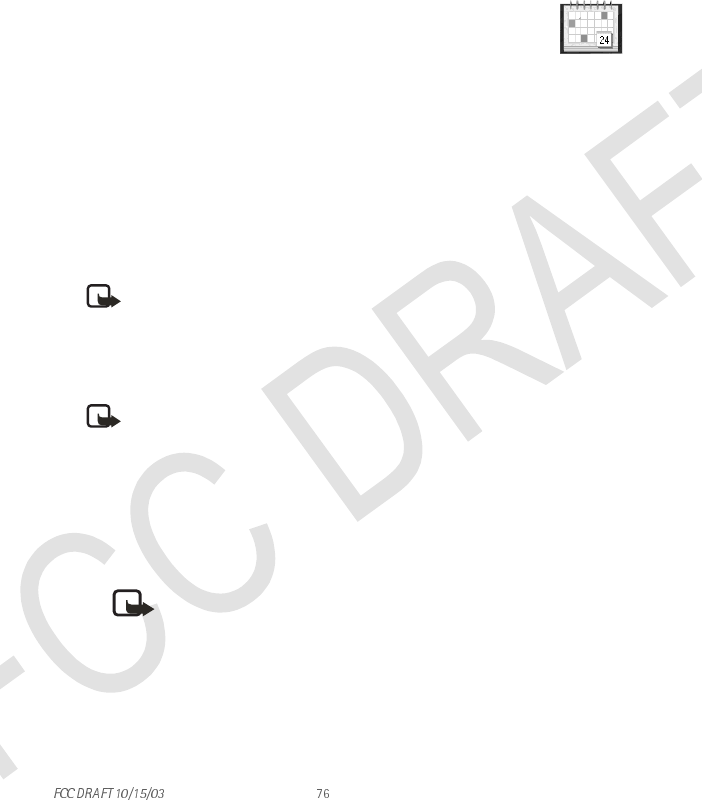
Copyright © Nokia 2003
13 Organizer
• ALARM CLOCK
The alarm clock uses the time format that has been set for the clock. The alarm clock works
even when the phone is switched off.
Select Menu > Organizer > Alarm clock.
•Select Alarm time, key in the alarm time and select OK.
To change the alarm time, select On.
•Select Alarm tone, and you can select a default alarm tone, personalize your alarm
tone by selecting one from the ringing tone list or from the gallery.
When the alarm time expires, the phone sounds an alert tone, and flashes Alarm! along with
the current time on the display.
Note: If the alarm time is reached while the phone is switched off, the phone
switches itself on and starts sounding the alarm tone. If you select Stop, the phone
prompts you to activate the phone for calls by displaying the option Switch the
phone on?. Select No to switch off the phone or Yes to make and receive calls.
Select Stop to stop the alarm. If you let the alarm continue for a minute or if you select
Snooze, the alarm stops for about ten minutes and then resumes.
Note: Do not select Yes when wireless phone use is prohibited or when it may
cause interference or danger.
•CALENDAR
The calendar helps you to keep track of reminders, calls that you need to make, meetings,
and birthdays.
The calendar uses shared memory. For more information, see “Shared memory” on page 7.
1Select Menu > Organizer > Calendar.
Note: To quickly view the current Calendar month, move the joystick to the
right in the standby mode.
2Scroll to the day that you want and select View.
The current day is indicated by a frame around the day. If there are any notes set for
the day, the day is shown in bold type.
3To view a single note, scroll to the desired note, and select View. You can scroll to view
the entire note.
4To perform other tasks, select Options and choose from the following:
• Make a note—to create a note.
6820.ENv1_9310322.book Page 76 Wednesday, October 15, 2003 1:43 PM

Nokia User Guide-FCC DRAFT 10/16/03 Copyright © Nokia 2003
Organizer
• Delete, Edit, or Move options—to erase, change, or move a note.
•Go to date—to go directly to a new date.
•Send note—to send the note to a compatible phone calendar using IR, calendar,
text message, MMS, or Bluetooth technology.
• Copy—to copy the note to another day.
•Settings—to set the date, time, date or time format, or the first day of the week.
In the Auto-delete option you can set the phone to automatically delete old notes
after a specified time. However, the repeated notes, for example birthday notes,
will not be deleted.
• Go to to-do list—to take a shortcut to the to-do list.
Add a calendar note
For information on keying in letters and numbers, see “Tips for writing text” on page 28.
Select Menu > Organizer > Calendar or move the joystick to the right in the standby mode
to go to the monthly view. Scroll to the date that you want, and select View. Select Add
note if there are no notes for the day, or select Options > Make a note and select:
• Calendar—Key in the note and select Save. (or select Options and search for the
name in contacts and select OK). Key in the location of the meeting, select Save. Key
in the start time for the meeting and select OK, and then key in the end time and select
OK To set the alarm for the note, select With tone or Silent (no alarm tone) and then
set the alarm time.
• Call—Key in the phone number, and select Save. Key in the name, select Save.
(Instead of keying in the phone number, search for the name and number in contacts).
Key in the time for the call and select OK. To set the alarm for the note, select With
tone or Silent (no alarm tone) and then set the alarm time.
• Birthday—Key in the name (or select Options and search for it in contacts) and
select Save. Then key in the year of birth and select OK. To set the alarm for the note,
select With tone or Silent (no alarm tone) and then set the alarm time.
• Note—Key in the note, and select Save. Key in the end day for the note and select
OK. To set the alarm for the note, select With tone or Silent (no alarm tone) and set
the alarm time.
• Reminder—Key in the subject for the reminder, and select Save. To set the alarm
for the note, select Alarm on and set the alarm time.
When you have set the alarm, the icon is displayed when you view the notes.
When the phone sounds an alarm for a note
The phone beeps and displays the note. When a call note icon is shown on the display,
you can call the displayed number by pressing the Send key. To stop the alarm and view the
note, select View. Select Snooze to phone returns to the standby mode To stop the alarm
without viewing the note, select Exit.
6820.ENv1_9310322.book Page 77 Wednesday, October 15, 2003 1:43 PM

Copyright © Nokia 2003
•TO-DO LIST
In the to-do list, you can save notes for tasks that you have to do and manage the tasks in
different ways.
The to-do list uses shared memory. For more information, see “Shared memory” on page 7.
Select Menu > Organizer > To-do list.
• To add a new note when the task list is empty, select Add note, or select Options and
select Add if you have saved tasks. Select Save and select the priority for the note High,
Medium, or Low. The phone automatically sets the deadline without an alarm for the
note. To change the deadline, view the note and select the option for deadline.
• In the task list, you can select Options, and select an option for, example to sort the
tasks by priority or by deadline, send them to another phone, save them as a calendar
note, or access the calendar.
• To view a task, scroll to the desired task on the list and select View. To edit the displayed
task, select Edit.
•NOTES
You can use the Notes application for writing and sending notes using IR, SMS or MMS. The
Notes application uses shared memory. For more information, see “Shared memory” on
page 7.
1Select Menu > Organizer > Notes, or type a character when the messaging keyboard
is open.
The phone will ask you to set the date and time, if they have not already been set when
you start to write a note.
2To add a new note, select Add note, if the list of notes is empty, or select Options >
Make a note.
To view a note, scroll to the desired note on the list and select View. To edit the
displayed note, select Edit.
3Key in the note and select Save.
If you select Options, you can select Insert time & date to add the current time and
date to the note. If there is not enough space for time and date, the phone will ask you
to delete the appropriate number of characters from your note.
You can also send the note using IR, Bluetooth connection, MMS, or as a text message
(SMS) to another compatible phone. If the note is too long to be sent as a text message,
the phone will ask you to delete the appropriate number of characters from your note.
6820.ENv1_9310322.book Page 78 Wednesday, October 15, 2003 1:43 PM

Nokia User Guide-FCC DRAFT 10/16/03 Copyright © Nokia 2003
Organizer
• WALLET
You can use the wallet to pay for your purchases made from the browser. You can save your
personal information, such as credit card numbers and addresses in the wallet, and then use
the data that are saved in the wallet during browsing. You can also save access codes to
mobile services that request a user name and password.
The data in the wallet is protected with a wallet code that you can define when you access
the wallet for the first time. At Create wallet code: key in the code and select OK to confirm
it and at Verify wallet code: key in the code again and select OK.
To delete all the contents of the wallet and the wallet code, key in *#7370925538# (*#res
wallet# in letters) in the standby mode. You also need the security code for the phone. See
“Access codes” on page 70.
Access the wallet
Select Menu > Organizer > Wallet. Key in your wallet code and select OK. You then can
choose from the following options:
Wallet profiles—to create card combinations, for example, for different services. A wallet
profile is helpful if the service asks you to fill in many data items. You can select the
appropriate wallet profile instead of selecting different cards separately.
Cards—to save personal card information. You can save payment card, loyalty card and
access card information, including information such as user name and password
combinations for different services.
Tickets—to save notifications of e-tickets that you have bought using your mobile service.
To view the tickets, scroll to the desired ticket and select View.
Receipts—to save receipts for mobile purchases.
Personal notes—to save all kinds of personal information that you want to protect by the
wallet PIN code.
Settings—to manage your wallet settings. For more information, see “Wallet settings” on
page 81.
Save card details
1Select Menu > Organizer > Wallet > Cards.
2Scroll to one of the following card types to save the details, and select Select:
•Payment card for credit and debit cards.
•Loyalty card for membership cards.
•Access card for personal user names and passwords to online services.
• Address card for basic contact information for home/office.
• User info card for customized personal preferences for online services.
6820.ENv1_9310322.book Page 79 Wednesday, October 15, 2003 1:43 PM

Copyright © Nokia 2003
3If there are no cards in the folder, select Add new to create a new card.
To view saved details of the card, scroll to the desired card and select View.
4Fill in the fields for the details and select Done.
You can also receive card information to your phone over the air from a card issuer or service
provider. You will be notified as to which category the card belongs to. Save or discard the
received card. You can view, but not edit the saved card. For availability of receiving card
information over the air, contact the card issuer or service provider.
Add personal notes
You can save personal notes, for example, account numbers, passwords, codes or notations.
Access the wallet and select Personal notes. To create a new personal note, select Add new.
To view a note, scroll to the desired note on the list and select View. To edit the displayed
note, select Edit.
When viewing a note, you can select the following options Send via text msg., Copy to
calendar or Use detail.
Create a wallet profile
When you have saved your personal card details, you can combine them together to create
a wallet profile. You can use the wallet profile to retrieve wallet data from different cards
while browsing.
1Access the wallet and select Wallet profiles.
2To create a new wallet profile, select Add new.
3Fill in the following fields and select Done. Some of the fields contain data that are
selected from the wallet. You need to save the data before you can create a wallet
profile.
• Wallet profile name: enter a name for the profile.
• Select payment card next—select a card from the payment card list.
• Select loyalty card next—select a card from the loyalty card list.
• Select access card next—select a card from the access card list.
• Select user info card next—select a card from the user data card list.
• Select billing address next—select an address from the address card list.
• Select shipping address next—select an address from the address card list.
• Select receipt delivery address next—select an address from the address card list.
• Select receipt delivery method next—select the way to deliver the receipt, Receipt
to phone number or Receipt to e-mail address.
6820.ENv1_9310322.book Page 80 Wednesday, October 15, 2003 1:43 PM

Nokia User Guide-FCC DRAFT 10/16/03 Copyright © Nokia 2003
Organizer
Wallet settings
Access the wallet and select Settings. Select
•Change code to change the wallet code.
•Phone ID to set the RFID code.
Guidelines for wallet purchases
To do your shopping, access the desired service site that supports the wallet. The service
needs to support the Electronic Commerce Language specification. See “Connect to a
service” on page 90.
Choose the product that you want to buy and read carefully all provided information before
your purchase.
Note: The text may not fit within a single screen. Therefore, make sure to scroll
through and read all of the text before your purchase.
• To pay for the items, the phone asks whether you want to use the wallet or not. The
phone also asks for your wallet PIN code.
• Select the card you want to pay with from the Payment cards list. Provided that the
data form you receive from the service provider supports the Electronic Commerce
Modeling Language specification, the phone automatically fills in the credit card
information or the wallet profile from the wallet.
• Approve the purchase, and the information is forwarded.
• You may receive an acknowledgement or a digital receipt of the purchase.
• To close the wallet, select Close wallet. If you do not use the wallet for 5 minutes, it
will be automatically closed.
Note: If you have tried to access or have accessed confidential information
requiring passwords (for example, your bank account), empty the cache of your
phone after each use.
• SYNCHRONIZATION
Synchronization allows you to save your calendar and contacts data on a remote Internet
server or on a compatible PC. If you have saved data on the remote Internet server, you can
synchronize your phone by starting the synchronization from the phone. Synchronizing to
the remote server is a network service. You can also synchronize your contact and calendar
data to correspond with the data on your compatible PC by starting the synchronization
from your PC. The contact data in your SIM card will not be synchronized.
Note: Answering an incoming call during synchronization will end the
synchronization process and you will need to restart it.
6820.ENv1_9310322.book Page 81 Wednesday, October 15, 2003 1:43 PM
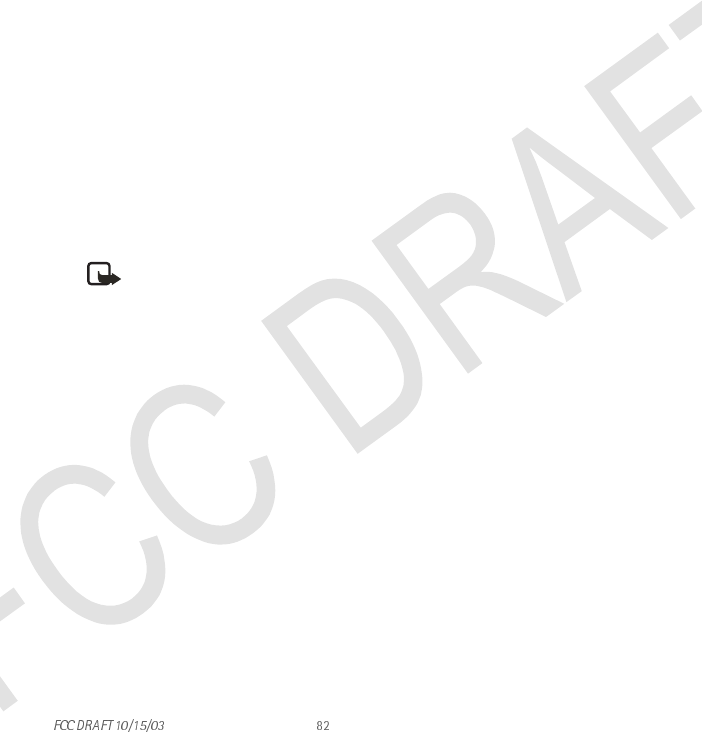
Copyright © Nokia 2003
Synchronize from your phone
Before synchronizing from your phone, you may need to do the following:
• Subscribe to a synchronization service. For more information on availability and the
synchronization service settings, contact your network operator or service provider.
• Retrieve the synchronization settings from your network operator or service provider.
• Set the connection settings you need for synchronization. See “How to set up the
phone for a service” on page 89.
To start the synchronization from your phone, use the following steps:
1Activate the connection settings that you need for synchronization. See “How to set up
the phone for a service” on page 89.
2Select Menu > Organizer > Synchronization > Settings > Active Internet sync.
settings.
3Scroll to the set you wish to activate and select Activate.
4Mark the data to be synchronized.
5Select Menu > Organizer > Synchronization > Synchronize.
The marked data in the active set will be synchronized after confirmation.
Note: Synchronizing for the first time or after an interrupted synchronization may
take up to 30 minutes to complete, if contacts or calendar are full.
Obtain synchronization settings
You may receive the synchronization settings as an over the air message from the network
operator or service provider. To receive the settings over the air, see “Over-the-air settings
service” on page 22.
To key in the settings manually, use the following steps:
1Select Menu > Organizer > Synchronization > Settings.
2Select Active Internet sync. settings. Scroll to the set you wish to activate, and select
Activate.
You need to activate the set where you want to save the synchronization settings. A
set is a collection of settings required to make a connection to a service.
3Select Edit active Internet sync. settings. Select each setting one by one and key in all
the required settings.
•Settings' name. Key in the name for the set and select OK.
• Data to be synchronized. Mark the data you want to synchronize, Contacts and/
or Calendar, and select Done.
• Database addresses. Select Contacts database and/or Calendar database.
•User name. Key in the user name and select OK.
• Password. Key in the password and select OK.
6820.ENv1_9310322.book Page 82 Wednesday, October 15, 2003 1:43 PM

Nokia User Guide-FCC DRAFT 10/16/03 Copyright © Nokia 2003
Organizer
• Synchronization server. Key in the name of the server and select OK.
• Connection settings to define connection settings required for synchronization.
Select each of the settings one by one and key in all the required settings. Contact
your network operator or service provider for the settings.
Select PC sync. settings to key in the settings for server alerted synchronization. Select
and key in User name and Password.
Synchronize from your PC
To synchronize contacts and the calendar from your PC, use an IR or Bluetooth connection,
or a data cable. You also need the PC Suite software of your phone installed on your PC.
Start the synchronization from your PC using PC suite.
6820.ENv1_9310322.book Page 83 Wednesday, October 15, 2003 1:43 PM

Copyright © Nokia 2003
14 Applications
• GAMES
The games use shared memory. For more information, see “Shared memory” on page 7.
About photosensitive seizures
A very small percentage of people may experience a seizure when exposed to certain visual
images, including flashing lights or patterns that may appear in video games. Even people
who have no history of seizures or epilepsy may have an undiagnosed condition that can
cause photosensitive epileptic seizures while watching video games. These seizures may
have a variety of symptoms, including lightheadedness, altered vision, eye or face twitching,
jerking or shaking of arms or legs, disorientation, confusion, or momentary loss of
awareness. Seizures may also cause loss of consciousness or convulsions that can lead to
injury from falling down or striking nearby objects.
Immediately stop playing and consult a doctor if you experience any of these symptoms.
Adults who allow teenagers (or children) to play the games should watch for or ask their
children about these symptoms as they are more likely than adults to experience these
seizures. The risk of photosensitive epileptic seizures may be reduced by playing in a well-
lit room and by not playing when you are drowsy or fatigued. If you or any of your relatives
have a history of seizures or epilepsy, consult a doctor before playing.
Play safely
Take a break from playing games at least every half hour. Stop playing immediately if you
begin to feel tired of if you experience an unpleasant sensation or pain in your hands or
arms. If the condition persists, consult a doctor.
How to play games
Select Menu > Applications > Games. Select:
•Select game and scroll to a game or a game set (the name depends on the game) and
select Open to launch a game. For functions that you can access by selecting Options
in the game list, see “Other options for an application or application set” on page 85.
•Game downloads to download a game to the phone.
•Memory to view the amount of memory that is available for game and application
installations.
•Settings to set sounds, lights and shakes for the game.
Note: Running some games may consume the battery faster (and you may
need to connect the phone to the charger).
6820.ENv1_9310322.book Page 84 Wednesday, October 15, 2003 1:43 PM
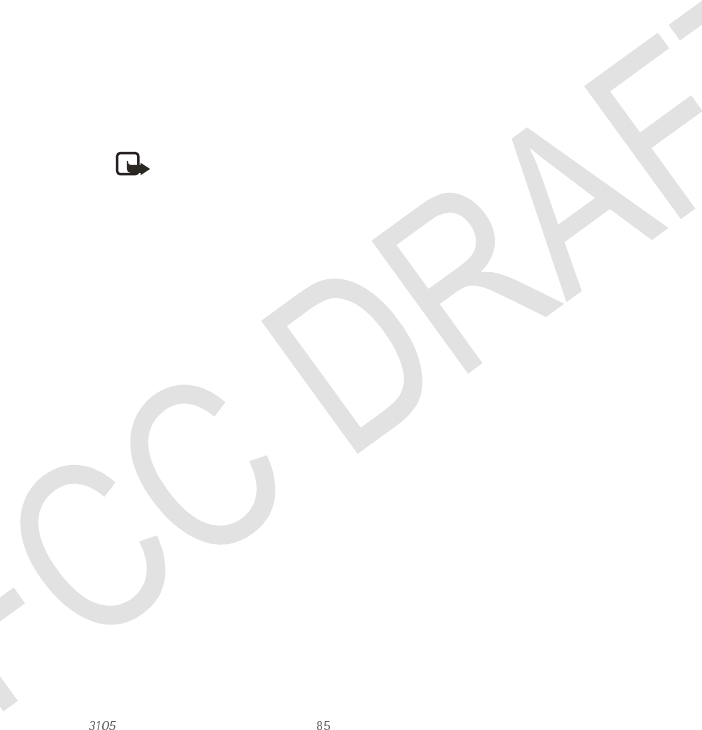
Nokia User Guide-FCC DRAFT 10/16/03 Copyright © Nokia 2003
Applications
• APPLICATIONS
The applications use shared memory. For more information, see “Shared memory” on page 7.
Select Menu > Applications > Applications. Select from the following options:
•Select application and scroll to an application or application set (the name depends on
the application) and select Open to launch an application. For functions that you can
access by selecting Options in the applications list, see “Other options for an
application or application set” on page 85.
•App. downloads to download an application to the phone.
•Memory to view the amount of memory that is available for game and application
installations.
Note: Running some applications may consume the battery faster and you
may need to connect the phone to the charger.
Other options for an application or application set
•Delete to delete the application or application set from your phone.
If you delete a pre-installed application or an application set from your phone, you may
download it again to your phone from the Nokia Software Market,
www.softwaremarket.nokia.com.
•Web access to restrict the application from accessing the network. Select Ask first and
the phone will ask you for net access, Allowed to allow the net access, or Not allowed
not to allow the net access.
•Update version to check if a new version of the application is available for download
from the services (network service).
•Web page to provide further information or additional data for the application from an
Internet page. This is a network service and the menu is shown only if an Internet
address has been provided with the application.
•Details to give additional information about the application.
Download a game or an application
Your phone supports J2METM Java games and applications. Make sure that the application
or a game is compatible with your phone before downloading it. You can download new
Java applications in different ways:
•Select Menu > Applications > Applications > App. downloads or select Menu >
Applications > Games > Game downloads.
The list of available browser bookmarks appears. Select More bookmarks to access the
list of bookmarks in the Services menu.
Select the appropriate bookmark to connect to the desired site. If the connection fails,
you may not be able to access the page from the service whose connection settings are
currently active. In this case, enter the Services menu and activate another set of
service settings. (See “Connect to a service” on page 90. (Try again to connect to the
6820.ENv1_9310322.book Page 85 Wednesday, October 15, 2003 1:43 PM

Copyright © Nokia 2003
site.
For the availability of different services, pricing and tariffs, contact your network
operator and/or the service provider.
•Select Menu > Services > Download links to download an appropriate application or
game.
• Use the Nokia Application installer from PC Suite to download the applications to your
phone.
When downloading a game or an application, it may be saved in the Games menu
instead of the Applications menu.
Note: Nokia does not warrant for applications from other sites. If you choose to
download Java applications from them, you should take the same precautions, for
security or content, as you would with any site.
•EXTRAS
Voice recorder
You can record pieces of speech, such as a name and phone number to write them down
later. The recorder cannot be used when a data call or connection is active.
Note: Obey all local laws governing recording of calls.
Make a recording
1Select Menu > Applications > Extras > Voice recorder.
2To start the recording, select Record. To start the recording during a call, select
Options > Record. While recording a call, all parties to the call will hear a faint beeping
sound.
When recording, hold the phone in the normal position near to your ear.
3To end the recording, select Stop. The recording will be saved in the Recordings folder
of the Gallery menu.
4To listen to the last recording, select Replay last. To send the recording as a multimedia
message, select
List of recordings
Select Menu > Applications > Extras > Voice recorder > Recordings list. The list of
folders in the Gallery appears. Scroll to Recordings, select Open and you can select some of
the options for files in the Gallery.
6820.ENv1_9310322.book Page 86 Wednesday, October 15, 2003 1:43 PM
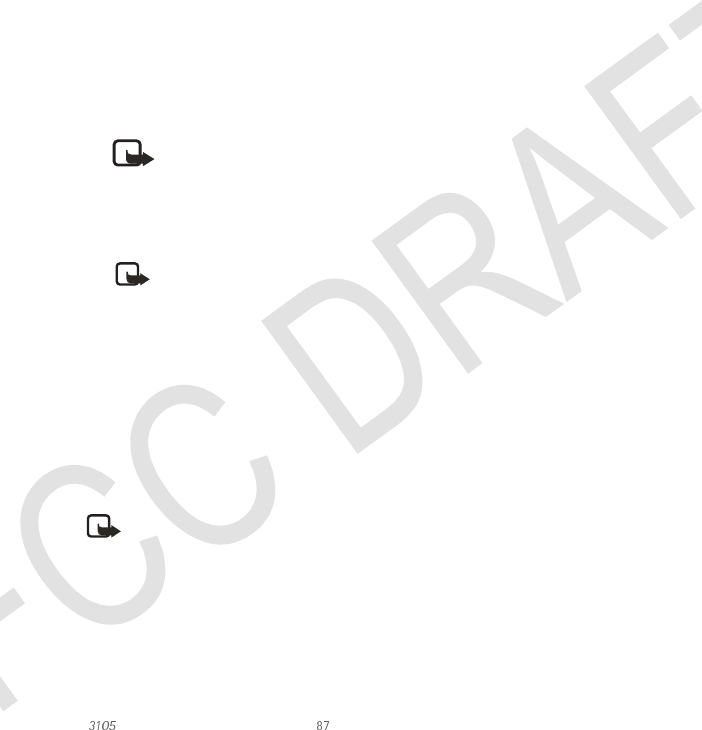
Nokia User Guide-FCC DRAFT 10/16/03 Copyright © Nokia 2003
Applications
Calculator
The calculator in your phone adds, subtracts, multiplies, divides, calculates the square and
the square root, and converts currency values.
1Select Menu > Applications > Extras > Calculator.
2When ’0’ is displayed on the screen, key in the first number of the calculation, press the
# key for a decimal point or the corresponding symbol on the keyboard, if the keyboard
is open.
3Select Options > Add, Subtract, Multiply, Divide, Square, Square root or Change sign.
If the keyboard is open, you can also use the corresponding calculation symbols of the
keyboard, if available.
Note: Alternatively, press the * key once to add, twice to subtract, three times
to multiply or four times to divide, if you are using the calculator with the
keyboard closed.
4Key in the second number.
5For the total, select Equals. Repeat steps 3 to 5 as many times as is necessary.
6To start a new calculation, press and hold Clear.
Note: This calculator has a limited accuracy and is designed for simple
calculations.
Convert currency
1Select Menu > Applications > Extras > Calculator.
2To save the exchange rate, select Options > Exchange rate. Select either of the
displayed options. Key in the exchange rate, press the # key for a decimal point, and
select OK. The exchange rate remains in the memory until you replace it with another
one.
3To perform the currency conversion, key in the amount to be converted, select
Options > In domestic or In foreign.
You can also perform the currency conversion in the standby mode. Key in the amount to
be converted, select Options > In domestic or In foreign.
Note: When you change base currency, you must key in the new rates because all
previously set exchange rates are set to zero.
Countdown timer
Select Menu > Applications > Extras > Countdown timer. Key in the time in hours and
minutes and select OK. If you wish, write a note that will be displayed when the time
expires, and select OK to start the countdown timer.
To change the countdown time, select Change time, or to stop the timer, select Stop timer.
6820.ENv1_9310322.book Page 87 Wednesday, October 15, 2003 1:43 PM

Copyright © Nokia 2003
If the alarm time is reached when the phone is in the standby mode, the phone sounds a
tone and shows the note, if available or Countdown time up. Stop the alarm by pressing
any key. If no key is pressed, the alarm stops automatically within 30 seconds. To stop the
alarm and to delete the note, select OK.
Stopwatch
You can measure time and take split or lap times using the stopwatch. During timing, the
other functions of the phone can be used. To set the stopwatch to run in the background,
press the End key.
Note: Using the stopwatch or allowing it to run in the background when using
other features increases the demand on battery power and reduces the battery life.
Take split times or lap times
1Select Menu > Applications > Extras > Stopwatch. Select Split timing or Lap timing
and select Start. You can select Continue if you have set the stopwatch to run in the
background.
2select Split to take a split time, Lap to take a lap time or Stop to stop the timing. You
can scroll through the split or lap times shown below the overall time.
3select Save to save the lap or split times as a set of times. To reset the times or to
continue timing, select Options > Reset or Start.
View and delete times
Select Menu > Applications > Extras > Stopwatch.
If the stopwatch has not been reset, you can select Show last to view the most recent
measured time. Select View times and a list of names or the final times of the time sets is
shown. Select the time set that you want to view.
To delete the saved times, select Delete times. Select Delete all and select OK, or select One
by one, scroll to the times that you want to delete, select Delete and select OK.
6820.ENv1_9310322.book Page 88 Wednesday, October 15, 2003 1:43 PM

Nokia User Guide-FCC DRAFT 10/16/03 Copyright © Nokia 2003
Services
15 Services
You can access various services with the multi-mode browser, such as
weather reports, news, flight times, financial information and
entertainment.
Check the availability of these services, pricing and tariffs with your network operator and/
or the service provider whose service you wish to use. Service providers will also give you
instructions on how to use their services.
With the multi-mode browser you can view the services that use wireless mark-up language
(WML) or extensible hypertext markup language (XHTML). Since the phone display area and
the memory capacity are much smaller than in a computer, Internet content is displayed
differently on the phone. You may not be able to view all details of the Internet pages.
• MAIN STEPS FOR USING SERVICES
1Save the service settings that are required to access the service that you want to use.
2Make a connection to the selected service.
3Start browsing the pages of the service.
4Once you are finished browsing, end the connection to the service.
• HOW TO SET UP THE PHONE FOR A SERVICE
You may receive the service settings as an over the air message from the network operator
or service provider that offers the service that you want to use.´You can also key in the
settings manually or add and edit the settings using PC Suite.
For more information and for the appropriate settings, contact the network operator or
service provider that offers the service that you want to use.
To receive the service settings over the air, see “Over-the-air settings service” on page 22.
Key in the service settings manually
1Select Menu > Services > Settings > Connection settings > Active service settings.
2Scroll to the connection set that you would like to activate and select Activate.
You need to activate the connection set where you want to save the service settings.
A connection set is a collection of settings that are required to connect to a service.
3Select Edit active service settings.
Select each of the settings one by one and key in all the required settings according to
the information you have received from your network operator or service provider.
Bearer-related settings are in the Bearer settings menu.
6820.ENv1_9310322.book Page 89 Wednesday, October 15, 2003 1:43 PM
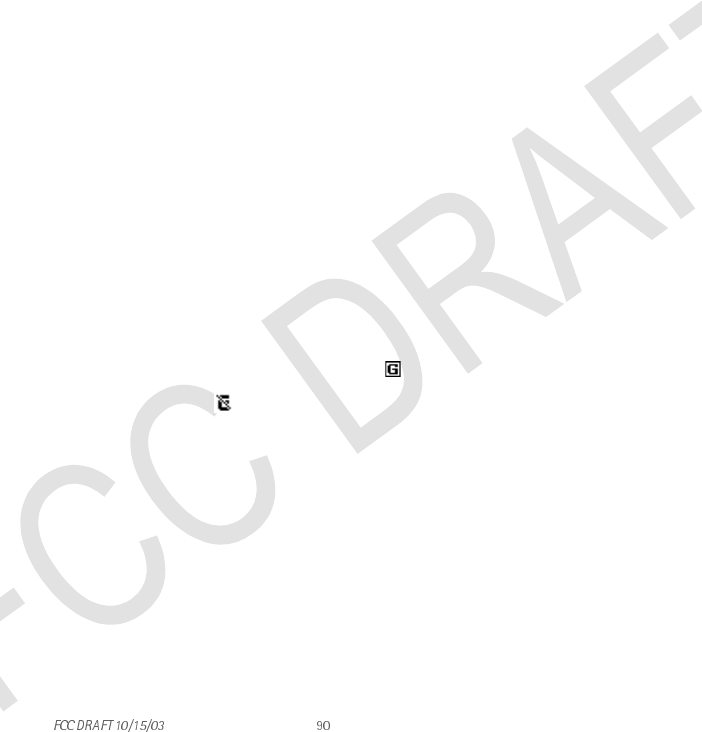
Copyright © Nokia 2003
Connect to a service
First, make sure that the service settings of the service that you want to use have been
activated. To activate the settings:
1Select Menu > Services > Settings > Connection settings > Active service settings.
2Scroll to the set you want to activate and select Activate.
Next, make a connection to the service. There are three ways to connect:
• Open the start page of the service, for example the home page of the service provider:
select Menu > Services > Home, or in the standby mode, press and hold the 0 key. If
the keyboard is open, press the corresponding number key.
• Select the bookmark of the service:
Select Menu > Services > Bookmarks, and select a bookmark.
If the bookmark does not work with the current active service settings, activate another
set of service settings and try again.
• Key in the address of the service:
Select Menu > Services > Go to address. Key in the address of the service, and select
OK. It is not necessary to add the prefix http:// in front of the address since it will be
added automatically.
Browse the pages of a service
After you have made a connection to the service, you can start browsing its pages. The
function of the phone keys may vary in different services. Follow the text guides on the
phone display. For more information, contact your service provider.
If EGPRS is selected as the data bearer, the icon is shown on the top left of the display
during browsing. If you receive a call or a text message, or make a call during an EGPRS
connection, the icon appears on the top right of the display to indicate that the EGPRS
connection has been suspended (on hold). After the call the phone tries to reconnect the
EGPRS connection.
USE THE PHONE KEYS WHILE BROWSING
• Move the joystick up or down to browse through the page.
• To select a highlighted item, press the joystick briefly or press the Send key.
• To enter letters and numbers, press the keys 0–9 and to enter special characters, press
the key the * key. When the keyboard is open, you can key in letters and numbers
normally.
OPTIONS WHILE BROWSING
select Options to view the following options that may be available. The service provider may
also offer other options. Select
•Home to return to the home page.
•Bookmarks. See “Bookmarks” on page 92.
•Download links to show the list of bookmarks for downloading.
6820.ENv1_9310322.book Page 90 Wednesday, October 15, 2003 1:43 PM

Nokia User Guide-FCC DRAFT 10/16/03 Copyright © Nokia 2003
Services
•Add bookmark to save the page as a bookmark.
•Shortcuts to open a new list of options that are, for example, specific to the page.
•Other options to show a list of other options, for example, options for the wallet and
some security options.
•Reload to reload and update the current page.
•Quit. See “Disconnect from a service” on page 91.
Note: If you access confidential information requiring passwords, such as your
bank account, empty the cache of your phone after each use. (See “Cache memory”
on page 93.
DIRECT CALLING
The multi-mode browser supports functions that you can access while browsing. You can
make a voice call, send DTMF tones while a voice call is in progress, and save a name and a
phone number from a page.
Disconnect from a service
To quit browsing and to end the connection, select Options > Quit. When Quit browsing?
is shown, select Yes.
Alternatively, press the End key twice. The phone ends the connection to the service.
Appearance settings of the multi-mode browser
While browsing, select Options > Other options > Appear. settings, or in the standby
mode, select Menu > Services, Settings > Appearance settings. Select:
•Text wrapping and select On if you want the text to continue on the next line or select
Off, if you want it to be abbreviated if it is too long to be shown on one line.
•Show images and select No, if you do not want the pictures on the page to be shown.
This can speed up the browsing of pages that contain a lot of pictures.
•Font size and select Small, Normal or Large.
•Alerts and select Alert for unsecure connection and Yes to set the phone to alert when
a secure connection changes to an unsecure one during browsing. Select Alert for
unsecure items and Yes to set the phone to alert when a secure page contains an
unsecure item.
•Encoding and select an option in Content encoding to change the encoding for the
web page content. The default value is Western. Select UTF-8 URLs and On, if you
want the phone to send an URL as an UTF-8 encoding.
Cookies
A cookie is data that a site saves in the browser cache memory of your phone. The data can
be, for example, your user information or your browsing preferences. Cookies will be saved
until you clear the cache memory, see “Cache memory” on page 93.
6820.ENv1_9310322.book Page 91 Wednesday, October 15, 2003 1:43 PM

Copyright © Nokia 2003
1While browsing, select Options > Other options > Security > Cookies, or in the
standby mode, select Menu > Services > Settings > Security settings > Cookies.
2Select Allow or Reject to allow or prevent the phone receiving cookies.
Bookmarks
You can save addresses as bookmarks in the phone memory.
1While browsing, select Options > Bookmarks, or in the standby mode, select Menu >
Services > Bookmarks.
2Select the desired bookmark or press the joystick briefly to make a connection to the
page associated with the bookmark.
3To manage bookmarks, select Options and select View, Edit, Delete, Send, or New
bookmark.
Your phone may have some pre-installed bookmarks for sites that are not affiliated to
Nokia. Nokia does not guarantee or endorse these sites. If you choose to access them, you
should take the same precautions for security and content as you would with any Internet
site.
RECEIVING A BOOKMARK
When you have received a bookmark as an Over The Air (OTA) message, select Save to add
it to the bookmark list, or select Options > View or Discard.
Downloads
1To download more tones, images, games or applications to your phone, select Menu >
Services > Download links.
2Select Tone downloads, Image downloads, Game downloads or App. downloads to
download tones, images, games or applications, respectively.
Download content only from sources you trust.
Service inbox
The phone is able to receive service messages (pushed messages) from your service provider.
To set the phone to receive service messages, select Menu > Services > Settings > Service
inbox settings > Service messages > On.
• To view a received service message, select View. If you select Exit the message is moved
to the Service inbox. To view the service message later, select Menu > Services >
Service inbox.
• While browsing, select Options > Other options > Service inbox. Scroll to the
message that you want and select Retrieve to download the marked content from the
web page, or select Options > Details or Delete.
6820.ENv1_9310322.book Page 92 Wednesday, October 15, 2003 1:43 PM

Nokia User Guide-FCC DRAFT 10/16/03 Copyright © Nokia 2003
Services
Cache memory
The information or services you have accessed are stored in the cache of your phone. A
cache is a buffer memory, which is used to store data temporarily.
To empty the cache while browsing, select Options > Other options > Clear the cache.
To empty the cache in the standby mode, select Menu > Services > Clear the cache.
Browser security
Security features may be required for some services, such as banking services or shopping
on a site. For such connections you need security certificates and possibly a security module,
which may be available on your SIM card. For more information, contact your service
provider.
IMPORTANT INFORMATION ABOUT CERTIFICATES
While the use of certificates makes the risks involved in remote connections and software
installation considerably smaller, they must be used correctly in order to benefit from
increased security. The existence of a certificate does not offer any protection by itself. The
certificate manager must contain correct, authentic, or trusted certificates for increased
security to be available.
Certificates have a restricted lifetime. If Expired certificate or Certificate not valid yet is
shown (even if the certificate should be valid), check that the current date and time in your
phone are correct.
Before changing these settings, make sure that you really trust the owner of the certificate
and that the certificate really belongs to the listed owner.
SECURITY MODULE
The security module can contain certificates as well as private and public keys. The security
module may improve the security services for applications requiring browser connection,
and allows you to use a digital signature. The certificates are saved in the security module
by the service provider.
Select Menu > Services > Settings > Security settings > Security module settings.
Select:
•Security module details to show the security module title, its status, manufacturer and
serial number.
•Module PIN request to set the phone to ask for the module PIN when using services
that are provided by the security module. Key in the code and select On. To disable the
module PIN request, select Off.
•Change module PIN to change the module PIN, if allowed by the security module. Key
in the current module PIN code; then key in the new code twice.
•Change signing PIN. Select the signing PIN that you want to change. Key in the current
PIN code; then key in the new code twice.
6820.ENv1_9310322.book Page 93 Wednesday, October 15, 2003 1:43 PM
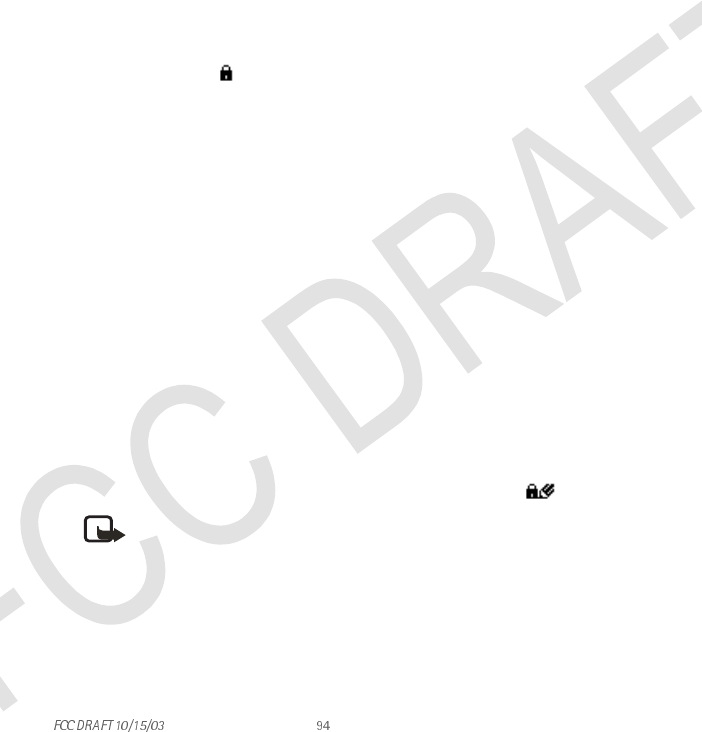
Copyright © Nokia 2003
CERTIFICATES
There are three kinds of certificates: server certificates, authority certificates and user
certificates.
• The phone uses a server certificate to improve security in connection between the
phone and the gateway. The phone receives the server certificate from the service
provider before the connection is established and its validity is checked using the
authority certificates that are saved on the phone. Server certificates are not saved.
The security icon is displayed during a connection if the data transmission between
the phone and the gateway (identified by the IP address in the Edit active service
settings) is encrypted.
However, the security icon is not an indication that the data transmission between the
gateway and the content server (place where the requested resource is saved) is secure.
It is up to the service provider to secure the data transmission between the gateway
and the content server.
• Authority certificates are used by some services, such as banking, for checking the
validity of other certificates. Authority certificates can be either saved in the security
module by the service provider, or they can be downloaded from the network, if the
service supports the use of authority certificates.
• User certificates are issued to users by a Certifying Authority. User certificates are
required, for example, to create a digital signature and they associate the user with a
specific private key in a security module.
DIGITAL SIGNATURE
You can create digital signatures with your phone. The signature can be traced back to you
through the private key in the security module and the user certificate that was used to
create the signature. Using the digital signature may be considered to be equal to a normal
signature on any legal document.
To create a digital signature, select a link on a page, for example, the title of the book you
want to buy and its price. The text that needs to be signed (possibly including amount, date,
etc.) will be shown.
Check that the header text is Read and that the digital signature icon is shown.
Note: If the digital signature icon does not appear, there is a security breach and
you should not enter any personal data such as your signing PIN.
To add the digital signature to the text, read all of the text first and then you can select
Sign. The text may not fit on a single screen. Therefore, make sure to scroll through and read
all of the text before signing.
Select the user certificate that you want to use. Key in the signing PIN and select OK. The
digital signature icon will disappear and the service may display a confirmation of your
purchase.
6820.ENv1_9310322.book Page 94 Wednesday, October 15, 2003 1:43 PM

Nokia User Guide-FCC DRAFT 10/16/03 Copyright © Nokia 2003
SIM services
16 SIM services
In addition to the functions that are available on the phone, your SIM
card may provide additional services that you can access in Menu 10.
Menu 10 is only shown if it is supported by your SIM card. The name and contents of the
menu depend entirely on the service available.
Note: For availability, rates and information on using SIM services, contact your
SIM card vendor.
You can set the phone to show you the confirmation messages that are sent between your
phone and the network when you are using the SIM services by selecting the option Yes
Confirm SIM service actions in Phone settings.
Note: Accessing these services may involve sending a text message (SMS) or
making a phone call for which you may be charged.
6820.ENv1_9310322.book Page 95 Wednesday, October 15, 2003 1:43 PM

Copyright © Nokia 2003
17 PC Connectivity
You can send and receive e-mail, and access the Internet when your phone is connected to
a compatible PC using an IR or Bluetooth connection, or a data cable. You can use your
phone with a variety of PC connectivity and data communications applications. With PC
Suite you can, for example synchronize contacts, calendar, to-do notes and notes between
your phone and the compatible PC.
You can find more information and downloadable files on the Nokia Website, www.nokia.
com/support/phones/6820.
•PC SUITE
The PC Suite contains the following applications:
• Nokia Application Installer to install Java applications from the compatible PC to the
phone.
• Nokia Image Converter to create images in supported formats for portrait images,
multimedia messages, or wallpapers, and to transfer them to your phone.
• Nokia Sound Converter to edit polyphonic ringing tones in supported formats to be
compatible with your phone and transfer them to your phone.
• Nokia Content Copier to copy data or back-up data from your phone to a compatible
PC or to another compatible Nokia phone.
• Nokia Settings Manager to edit and send your browser bookmarks or update the
connection sets to your phone.
• Nokia Phone Editor to send text messages (SMS) and edit the contacts in your phone.
• Nokia Phone Browser to view the contents of the Gallery folder of your phone on a
compatible PC. You can browse picture and audio files in the phone memory and to
transfer them between phone and PC.
• Nokia Multimedia Player to play multimedia (MMS) messages, and audio and video
files. You can also create playlists of your favorite multimedia files.
• Nokia PC Sync to synchronize contacts, calendar, to-do notes and notes between your
phone and your PC.
• Nokia 6820 data modem drivers enable you to use your phone as a modem.
• Nokia Modem Options contains settings for HSCSD and GPRS connections.
• Nokia Connection Manager to select the connection type between the PC and the
phone.
Copyright protections may prevent some images, ringing tones and other content from
being copied, modified, transferred or forwarded.
6820.ENv1_9310322.book Page 96 Wednesday, October 15, 2003 1:43 PM
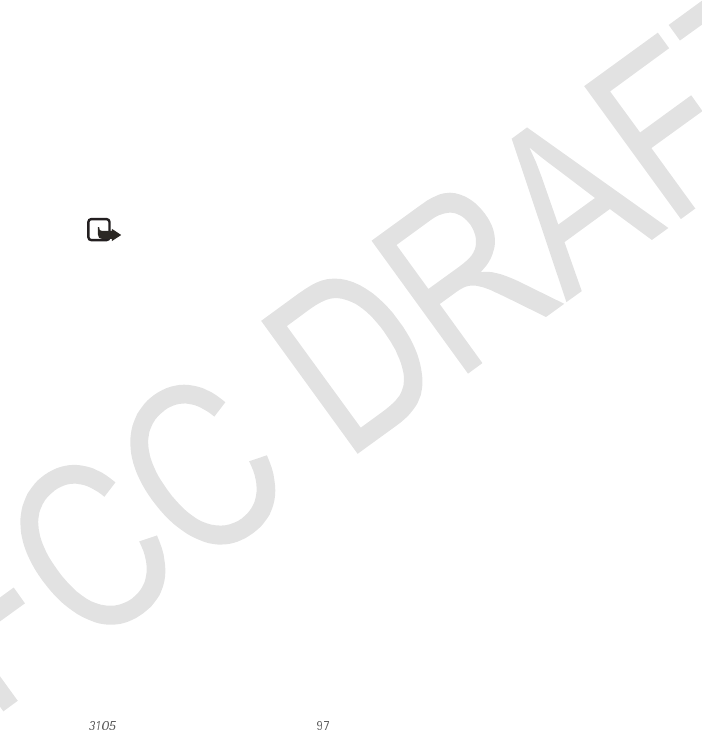
Nokia User Guide-FCC DRAFT 10/16/03 Copyright © Nokia 2003
PC Connectivity
EGPRS, HSCSD and CSD
You can use the EGPRS (enhanced GPRS), GPRS (general packet radio service), HSCSD (high
speed circuit switched data) and CSD (circuit switched data, GSM data) data services.
For availability and subscription to data services, contact your network operator or service
provider.
The use of HSCSD service consumes the battery more quickly than normal voice or data
calls. You may need to connect the phone to a charger for the duration of data transfer.
For more information, see “EGPRS modem settings” on page 67.
• DATA COMMUNICATIONS APPLICATIONS
For information on using a data communications application, refer to the documentation
provided with it.
Note: Making or answering phone calls during a computer connection is not
recommended as it might disrupt the operation.
For a better performance during data calls, place the phone on a stationary surface with the
keypad facing downward. Do not move the phone or hold it in your hand during a data call.
6820.ENv1_9310322.book Page 97 Wednesday, October 15, 2003 1:43 PM
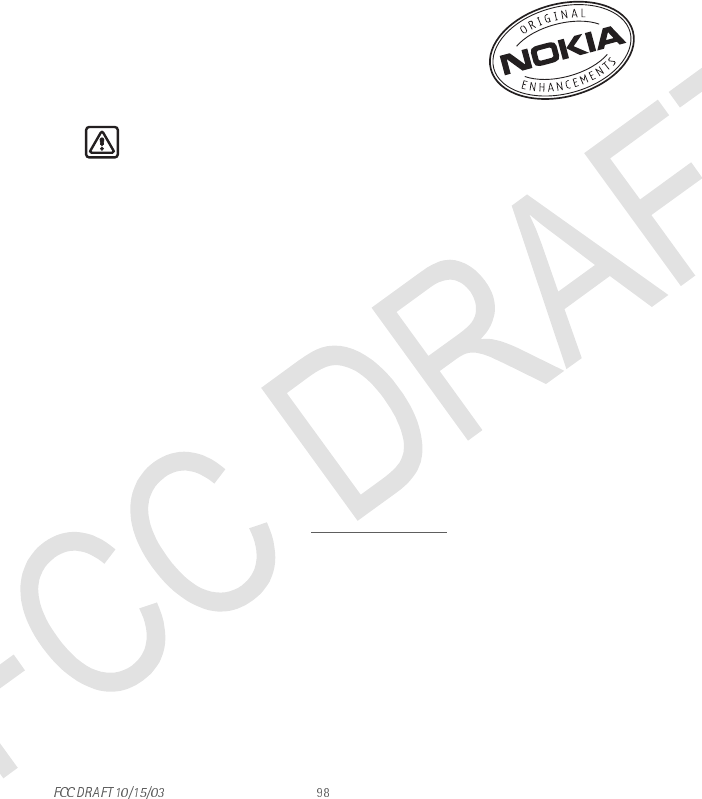
Copyright © Nokia 2003
18 Enhancements
This section provides information about the batteries,
chargers, and accessories for your phone. Be aware that the
information in this section is subject to change as the
batteries, chargers, and accessories change.
Warning:Use only batteries, chargers and accessories approved by the phone
manufacturer for use with this particular phone model. The use of any other types
may invalidate any approval or warranty applying to the phone, and may be
dangerous. For availability of approved accessories, please check with your dealer.
•SAFETY
• Keep all enhancements out of the reach of small children.
• When you disconnect the power cord of any enhancement, grasp and pull the plug, not
the cord.
• Check regularly that any vehicle-installed enhancements are mounted and are
operating properly.
• Installation of any complex car enhancements must be made by qualified personnel
only.
Check the model number of any charger before use with this device. This device is intended
for use when supplied with power from ACP-7, ACP-8, ACP-9, ACP-12, LCH-8, LCH-9, LCH-
12, and ACH-1.
• ENHANCEMENTS FOR YOUR PHONE
For detailed information on accessories and enhancements, contact your authorized Nokia
dealer or visit the Nokia Web site at www.nokia.com/us.
Audio
• Wireless Headset (HDW-2)
• Wireless Clip-on Headset (HS-3W)
• Wireless Boom Headset (HS-4W)
• Boom Headset (HDB-4)
• Headset (HS-5)
• Retractable Headset (HS-10)
Car
• Wireless Car Kit (CARK112)
• Wireless Car Kit (CK-1W)
6820.ENv1_9310322.book Page 98 Wednesday, October 15, 2003 1:43 PM

Nokia User Guide-FCC DRAFT 10/16/03 Copyright © Nokia 2003
Enhancements
• Car Installation Kit (CARK 126)
Imaging
• Nokia Observation Camera
• Image Frames (SU-4/7)
•Image Viewer (SU-2)
Messaging
• Digital Pen
Data
• Data Cable (DKU-5)
• Desktop Stand (DCV-14)
Power
• Battery, 850 mAh, Li-ion (BL-5C)
• Retractable Charger (AC-1)
• Travel Charger (ACP 12)
6820.ENv1_9310322.book Page 99 Wednesday, October 15, 2003 1:43 PM

Copyright © Nokia 2003
19 Reference Information
• BATTERY INFORMATION
Charging and Discharging
Your phone is powered by a rechargeable battery.
A new battery’s full performance is achieved only after two or three complete charge and
discharge cycles!
The battery can be charged and discharged hundreds of times but it will eventually wear
out. When the operating time (talk time and standby time) is noticeably shorter than
normal, it is time to buy a new battery.
Use only batteries approved by the phone manufacturer and recharge your battery only with
the chargers approved by the manufacturer. Unplug the charger when not in use. Do not
leave the battery connected to a charger for longer than a week, since overcharging may
shorten its lifetime. If left unused a fully charged battery will discharge itself over time.
Temperature extremes can affect the ability of your battery to charge.
Use the battery only for its intended purpose.
Never use any charger or battery which is damaged.
Do not short-circuit the battery. Accidental short-circuiting can occur when a metallic
object (coin, clip or pen) causes direct connection of the + and - terminals of the battery
(metal strips on the battery) for example when you carry a spare battery in your pocket or
purse. Short-circuiting the terminals may damage the battery or the connecting object.
Leaving the battery in hot or cold places, such as in a closed car in summer or winter
conditions, will reduce the capacity and lifetime of the battery. Always try to keep the
battery between 15°C and 25°C (59° F and 77° F). A phone with a hot or cold battery may
temporarily not work, even when the battery is fully charged. Batteries' performance is
particularly limited in temperatures well below freezing.
Do not dispose of batteries in a fire!
Dispose of batteries according to local regulations (such as recycling). Do not dispose as
household waste.
Battery operation times
Battery talk and standby times are estimates only and depend on signal strength, network
conditions, features used, battery age and condition (including the effect of charging
habits), temperatures to which battery is exposed, use in digital mode, and many other
6820.ENv1_9310322.book Page 100 Wednesday, October 15, 2003 1:43 PM

Nokia User Guide-FCC DRAFT 10/16/03 Copyright © Nokia 2003
Reference Information
factors. Please note that the amount of time a phone is used for calls will affect its standby
time. Likewise, the amount of time that the phone is turned on and in the standby mode
will affect its talk time.
• CARE AND MAINTENANCE
Your phone is a product of superior design and craftsmanship and should be treated with
care. The suggestions below will help you to fulfil any warranty obligations and to enjoy this
product for many years.
• Keep the phone and all its parts and accessories out of the reach of small children.
• Keep the phone dry. Precipitation, humidity and all types of liquids or moisture can
contain minerals that will corrode electronic circuits.
• Do not use or store the phone in dusty, dirty areas. Its moving parts can be damaged.
• Do not store the phone in hot areas. High temperatures can shorten the life of
electronic devices, damage batteries, and warp or melt certain plastics.
• Do not store the phone in cold areas. When it warms up (to its normal temperature),
moisture can form inside, which may damage electronic circuit boards.
• Do not attempt to open the phone. Non-expert handling may damage it.
• Do not drop, knock or shake the phone. Rough handling can break internal circuit
boards.
• Do not use harsh chemicals, cleaning solvents, or strong detergents to clean the phone.
• Do not paint the phone. Paint can clog the moving parts and prevent proper operation.
• Use only the supplied or an approved replacement antenna. Unauthorized antennas,
modifications or attachments could damage the phone and may violate regulations
governing radio devices.
All of the above suggestions apply equally to your phone, battery, charger or any accessory.
If any of them is not working properly, take it to your nearest qualified service facility. The
personnel there will assist you and, if necessary, arrange for service.
• TRAFFIC SAFETY
Do not use a hand-held telephone while driving a vehicle. Always secure the phone in its
holder; do not place the phone on the passenger seat or where it can break loose in a
collision or sudden stop.
Remember road safety always comes first!
• OPERATING ENVIRONMENT
Remember to follow any special regulations in force in any area and always switch off your
phone whenever it is forbidden to use it, or when it may cause interference or danger.
6820.ENv1_9310322.book Page 101 Wednesday, October 15, 2003 1:43 PM

Copyright © Nokia 2003
Use the phone only in its normal operating positions.
Parts of the phone are magnetic. Metallic materials may be attracted to the phone, and
persons with a hearing aid should not hold the phone to the ear with the hearing aid. Always
secure the phone in its holder, because metallic materials may be attracted by the earpiece.
Do not place credit cards or other magnetic storage media near the phone, because
information stored on them may be erased.
• ELECTRONIC DEVICES
Most modern electronic equipment is shielded from radio frequency (RF) signals. However,
certain electronic equipment may not be shielded against the RF signals from your wireless
phone.
Pacemakers
Pacemaker manufacturers recommend that a minimum separation of 6 inches (20 cm)
maintained between a handheld wireless phone and a pacemaker to avoid potential
interference with the pacemaker. These recommendations are consistent with the
independent research by and recommendations of Wireless Technology Research. Persons
with pacemakers:
• Should always keep the phone more than 6 inches (20 cm) from their pacemaker when
the phone is switched on;
• Should not carry the phone in a breast pocket;
• Should use the ear opposite the pacemaker to minimize the potential for interference.
• If you have any reason to suspect that interference is taking place, switch off your
phone immediately.
Hearing aids
Some digital wireless phones may interfere with some hearing aids. In the event of such
interference, you may want to consult your service provider.
Other medical devices
Operation of any radio transmitting equipment, including cellular phones, may interfere
with the functionality of inadequately protected medical devices. Consult a physician or the
manufacturer of the medical device to determine if they are adequately shielded from
external RF energy or if you have any questions. Switch off your phone in health care
facilities when any regulations posted in these areas instruct you to do so. Hospitals or
health care facilities may be using equipment that could be sensitive to external RF energy.
6820.ENv1_9310322.book Page 102 Wednesday, October 15, 2003 1:43 PM

Nokia User Guide-FCC DRAFT 10/16/03 Copyright © Nokia 2003
Reference Information
Vehicles
RF signals may affect improperly installed or inadequately shielded electronic systems in
motor vehicles (e.g. electronic fuel injection systems, electronic anti-skid (anti-lock) braking
systems, electronic speed control systems, air-bag systems). Check with the manufacturer
or its representative regarding your vehicle. You should also consult the manufacturer of
any equipment that has been added to your vehicle.
Posted facilities
Switch your phone off in any facility where posted notices so require.
• POTENTIALLY EXPLOSIVE ENVIRONMENTS
Switch off your phone when in any area with a potentially explosive atmosphere and obey
all signs and instructions. Sparks in such areas could cause an explosion or fire resulting in
bodily injury or even death.
Users are advised to switch off the phone when at a refuelling point (service station). Users
are reminded of the need to observe restrictions on the use of radio equipment in fuel
depots (fuel storage and distribution areas), chemical plants or where blasting operations
are in progress.
Areas with a potentially explosive atmosphere are often but not always clearly marked. They
include below deck on boats; chemical transfer or storage facilities; vehicles using liquefied
petroleum gas (such as propane or butane); areas where the air contains chemicals or
particles, such as grain, dust or metal powders; and any other area where you would
normally be advised to turn off your vehicle engine.
•VEHICLES
Only qualified personnel should service the phone, or install the phone in a vehicle. Faulty
installation or service may be dangerous and may invalidate any warranty which may apply
to the unit.
Check regularly that all wireless phone equipment in your vehicle is mounted and operating
properly.
Do not store or carry flammable liquids, gases or explosive materials in the same
compartment as the phone, its parts or accessories.
For vehicles equipped with an air bag, remember that an air bag inflates with great force.
Do not place objects, including both installed or portable wireless equipment in the area
over the air bag or in the air bag deployment area. If in-vehicle wireless equipment is
improperly installed and the air bag inflates, serious injury could result.
6820.ENv1_9310322.book Page 103 Wednesday, October 15, 2003 1:43 PM

Copyright © Nokia 2003
Using your phone while in the air is prohibited. Switch off your phone before boarding an
aircraft. The use of wireless telephones in an aircraft may be dangerous to the operation of
the aircraft, disrupt the wireless telephone network and may be illegal.
Failure to observe these instructions may lead to suspension or denial of telephone services
to the offender, or legal action or both.
• EMERGENCY CALLS
Important:This phone, like any wireless phone, operates using radio signals,
wireless and landline networks as well as user-programmed functions. Because of
this, connections in all conditions can not be guaranteed. Therefore, you should
never rely solely upon any wireless phone for essential communications (such as
medical emergencies).
Emergency calls may not be possible on all wireless phone networks or when certain
network services and/or phone features are in use. Check with local service providers.
To make an emergency call:
1If the phone is not on, switch it on. Check for adequate signal strength.
Some networks may require that a valid SIM card is properly inserted in the phone.
2Press the End key as many times as needed (to exit a call, to exit a menu, etc.) to clear
the display and ready the phone for calls.
3Key in the emergency number for your present location. Emergency numbers vary by
location.
4Press the Send key
If certain features are in use, you may first need to turn those features off before you can
make an emergency call. Consult this guide and your local cellular service provider.
When making an emergency call, remember to give all the necessary information as
accurately as possible. Remember that your wireless phone may be the only means of
communication at the scene of an accident - do not cut off the call until given permission
to do so.
CERTIFICATION INFORMATION (SAR)
THIS MODEL PHONE MEETS THE GOVERNMENT’S REQUIREMENTS FOR EXPOSURE TO RADIO
WAVES.
Your wireless phone is a radio transmitter and receiver. It is designed and manufactured not
to exceed the emission limits for exposure to radio frequency (RF) energy set by the Federal
Communications Commission of the U.S. Government. These limits are part of
comprehensive guidelines and establish permitted levels of RF energy for the general
population. The guidelines are based on standards that were developed by independent
6820.ENv1_9310322.book Page 104 Wednesday, October 15, 2003 1:43 PM

Nokia User Guide-FCC DRAFT 10/16/03 Copyright © Nokia 2003
Reference Information
scientific organizations through periodic and thorough evaluation of scientific studies. The
standards include a substantial safety margin designed to assure the safety of all persons,
regardless of age and health.
The exposure standard for wireless mobile phones employs a unit of measurement known
as the Specific Absorption Rate, or SAR. The SAR limit set by the FCC is 1.6W/kg.* Tests for
SAR are conducted using standard operating positions accepted by the FCC with the phone
transmitting at its highest certified power level in all tested frequency bands. Although the
SAR is determined at the highest certified power level, the actual SAR level of the phone
while operating can be well below the maximum value. This is because the phone is
designed to operate at multiple power levels so as to use only the power required to reach
the network. In general, the closer you are to a wireless base station antenna, the lower the
power output.
Before a phone model is available for sale to the public, it must be tested and certified to
the FCC that it does not exceed the limit established by the government-adopted
requirement for safe exposure. The tests are performed in positions and locations (for
example, at the ear and worn on the body) as required by the FCC for each model.
The highest SAR value for the Nokia 6820a model phone as reported to the FCC when tested
for use at the ear is 0.66 W/kg, and when worn on the body, as described in this user guide,
is 1.20 W/kg. The highest SAR value for the Nokia 6820b model phone as reported to the
FCC when tested for use at the ear is X.XX W/kg, and when worn on the body, as described
in this user guide, is X.XX W/kg.(Body-worn measurements differ among phone models,
depending upon available enhancements and FCC requirements).
While there may be differences between the SAR levels of various phones and at various
positions, they all meet the government requirement. The FCC has granted an Equipment
Authorization for this model phone with all reported SAR levels evaluated as in compliance
with the FCC RF exposure guidelines. SAR information on this model phone is on file with
the FCC and can be found under the Display Grant section of http://www.fcc.gov/oet/fccid
after searching on FCC ID PYANHL-9 for the Nokia 6280a model and FCC ID XXXXXX-X for
the Nokia 6820b model.
For body worn operation, this phone has been tested and meets the FCC RF exposure
guidelines for use with a carry case, belt clip, or holder that contains no metal and that
positions the handset a minimum of 5/8-inch (1.5 cm) from the body. Use of other carry
cases, belt clips, or holders may not ensure compliance with FCC RF exposure guidelines. If
you do not use a body-worn accessory and are not holding the phone at the ear, position
the handset a minimum of 5/8-inch (1.5 cm) from your body when the phone is switched on.
*In the United States and Canada, the SAR limit for mobile phones used by the public is 1.6
watts/kilogram (W/kg) averaged over one gram of tissue. The standard incorporates a
substantial margin of safety to give additional protection for the public and to account for
any variations in measurements. SAR values may vary depending on national reporting
requirements and the network band. For SAR information in other regions please look under
product information at www.nokia.com.
6820.ENv1_9310322.book Page 105 Wednesday, October 15, 2003 1:43 PM
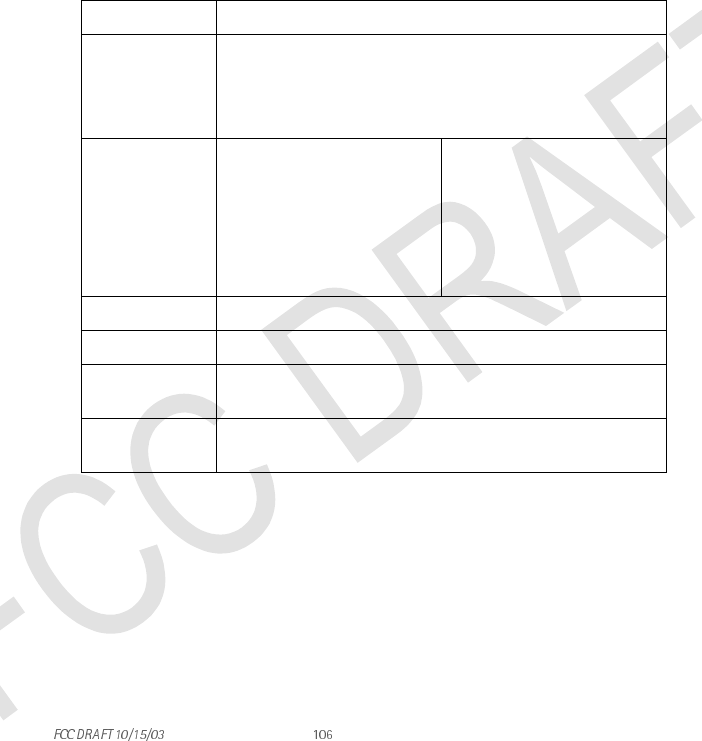
Copyright © Nokia 2003
20 Technical information
Weight 3.5 oz (100 g) with BL-5C 850–mAh semi-fixed Li-Ion Battery
Size Volume: 4.8 cubic inches (79 cc)
Weight: 3.5 oz (100 g)
Length: 4.2 in (106.1 mm closed)
Width: 1.8 in (46.1 mm) at hinges, 1.5 in (38 mm) at bottom
Thickness: .8 in (21.6 mm) at top, .7 in (17 mm at bottom)
Frequency range 6820a
EGSM900 880.2-914.8 MHz (TX)
92.5-959.8 MHz (RX)
GSM1800 1710.2-1784.8 MHz (TX)
1805.2-1879.8 (RX)
GSM1900 1850.2-1909.8 MHz (TX)
1930.2-1989.8 (RX)
6820b
GSM850 824.2-848.8 MHz (TX)
869.2-893.8 MHz (RX)
GSM1800 1710.2-1784.8 MHz (TX)
1805.2-1879.8 (RX)
GSM1900 1850.2-1909.8 MHz (TX)
1930.2-1989.8 (RX)
Tx output power Up to 2 W
Battery voltage 3.7 V
Operating
temperature
14°F to + 131°F (-10°C to +55°C)
aTalk time,
standby time
a. Battery talk and standby times are estimates only and depend on signal strength, network con-
ditions, features used, battery age and condition (including the effect of charging habits), tem-
peratures to which battery is exposed, use in digital mode, and many other factors. Please note
that the amount of time a phone is used for calls will affect its standby time. Likewise, the
amount of time that the phone is turned on and in the standby mode will affect its talk time.
Talk time: up to 7 hours
Stand-by time: up to 10 days
6820.ENv1_9310322.book Page 106 Wednesday, October 15, 2003 1:43 PM

Nokia User Guide-FCC DRAFT 10/16/03 Copyright © Nokia 2003
Nokia One-Year Limited Warranty
21 Nokia One-Year Limited Warranty
Nokia Inc. (“Nokia”) warrants that this cellular phone (“Product”) is free from defects in
material and workmanship that result in Product failure during normal usage, according to
the following terms and conditions:
1The limited warranty for the Product extends for ONE (1) year beginning on the date of
the purchase of the Product. This one year period is extended by each whole day that
the Product is out of your possession for repair under this warranty.
2The limited warranty extends only to the original purchaser (“Consumer”) of the Product
and is not assignable or transferable to any subsequent purchaser/end-user.
3The limited warranty extends only to Consumers who purchase the Product in the
United States of America.
4During the limited warranty period, Nokia will repair, or replace, at Nokia’s sole option,
any defective parts, or any parts that will not properly operate for their intended use
with new or refurbished replacement items if such repair or replacement is needed
because
of product malfunction or failure during normal usage. No charge
will be made to the Consumer for any such parts. Nokia will also
pay for the labor charges incurred by Nokia in repairing or replacing the defective parts.
The limited warranty does not cover defects in appearance, cosmetic, decorative or
structural items, including framing, and any non-operative parts. Nokia’s limit of
liability under the limited warranty shall be the actual cash value of the Product at the
time the Consumer returns the Product for repair, determined by the price paid by the
Consumer for the Product less a reasonable amount for usage. Nokia shall not be liable
for any other losses or damages. These remedies are the Consumer’s exclusive remedies
for breach of warranty.
5Upon request from Nokia, the Consumer must prove the date of the original purchase
of the Product by a dated bill of sale or dated itemized receipt.
6The Consumer shall bear the cost of shipping the Product to Nokia in Melbourne,
Florida. Nokia shall bear the cost of shipping the Product back to the Consumer after
the completion of service under this limited warranty.
7The Consumer shall have no coverage or benefits under this limited warranty if any of
the following conditions are applicable:
•The Prodυct has been subjected to abnormal use, abnormal conditions, improper
storage, exposure to moisture or dampness, unauthorized modifications,
unauthorized connections, unauthorized repair, misuse, neglect, abuse, accident,
alteration, improper installation, or other acts which are not the fault of Nokia,
including damage caused by shipping.
•The Product has been damaged from external causes such as collision with an
object, or from fire, flooding, sand, dirt, windstorm, lightning, earthquake or
damage from exposure to weather conditions, an Act of God, or battery leakage,
6820.ENv1_9310322.book Page 107 Wednesday, October 15, 2003 1:43 PM

Copyright © Nokia 2003
theft, blown fuse, or improper use of any electrical source, damage caused by
computer or internet viruses, bugs, worms, Trojan Horses, cancelbots or damage
caused by the connection to other products not recommended for interconnection
by Nokia.
•Nokia was not advised in writing by the Consumer of the alleged defect or
malfunction of the Product within fourteen (14) days after the expiration of the
applicable limited warranty period.
•The Product serial number plate or the accessory data code has been removed,
defaced or altered.
•The defect or damage was caused by the defective function of the cellular system
or by inadequate signal reception by the external antenna, or viruses or other
software problems introduced into the Product.
8Nokia does not warrant uninterrupted or error-free operation of the Product. If a
problem develops during the limited warranty period, the Consumer shall take the
following step-by-step procedure:
•The Consumer shall return the Product to the place of purchase for repair or
replacement processing.
•If “a” is not convenient because of distance (more than 50 miles) or for other good
cause, the Consumer shall ship the Product prepaid and insured to:
Nokia Inc., Attn: Repair Department
795 West Nasa Blvd.
Melbourne, FL 32901
•The Consumer shall include a return address, daytime phone number and/or fax
number, complete description of the problem, proof of purchase and service
agreement (if applicable). Expenses related to removing the Product from an
installation are not covered under this limited warranty.
•The Consumer will be billed for any parts or labor charges not covered by this
limited warranty. The Consumer will be responsible for any expenses related to
reinstallation of the Product.
•Nokia will repair the Product under the limited warranty within 30 days after
receipt of the Product. If Nokia cannot perform repairs covered under this limited
warranty within 30 days, or after a reasonable number of attempts to repair the
same defect, Nokia at its option, will provide a replacement Product or refund the
purchase price of the Product less a reasonable amount for usage. In some states
the Consumer may have the right to a loaner if the repair of the Product takes
more than ten (10) days. Please contact the Customer Service Center at Nokia at
the telephone number listed at the end of this warranty if you need a loaner and
the repair of the Product has taken or is estimated to take more than ten (10) days.
•If the Product is returned during the limited warranty period, but the problem with
the Product is not covered under the terms and conditions of this limited warranty,
6820.ENv1_9310322.book Page 108 Wednesday, October 15, 2003 1:43 PM

Nokia User Guide-FCC DRAFT 10/16/03 Copyright © Nokia 2003
Nokia One-Year Limited Warranty
the Consumer will be notified and given an estimate of the charges the Consumer
must pay to have the Product repaired, with all shipping charges billed to the
Consumer. If the estimate is refused, the Product will be returned freight collect.
If the Product is returned after the expiration of the limited warranty period,
Nokia’s normal service policies shall apply and the Consumer will be responsible for
all shipping charges.
9You (the Consumer) understand that the product may consist of refurbished equipment
that contains used components, some of which have been reprocessed. The used
components comply with Product performance and reliability specifications.
10 ANY IMPLIED WARRANTY OF MERCHANTABILITY, OR FITNESS FOR A PARTICULAR
PURPOSE OR USE, SHALL BE LIMITED TO THE DURATION OF THE FOREGOING LIMITED
WRITTEN WARRANTY. OTHERWISE, THE FOREGOING LIMITED WARRANTY IS THE
CONSUMER’S SOLE AND EXCLUSIVE REMEDY AND IS IN LIEU OF ALL OTHER
WARRANTIES, EXPRESS OR IMPLIED. NOKIA SHALL NOT BE LIABLE FOR SPECIAL,
INCIDENTAL, PUNITIVE OR CONSEQUENTIAL DAMAGES, INCLUDING BUT NOT LIMITED
TO LOSS OF ANTICIPATED BENEFITS OR PROFITS, LOSS OF SAVINGS OR REVENUE, LOSS
OF DATA, PUNITIVE DAMAGES, LOSS OF USE OF THE PRODUCT OR ANY ASSOCIATED
EQUIPMENT, COST OF CAPITAL, COST OF ANY SUBSTITUTE EQUIPMENT OR FACILITIES,
DOWNTIME, THE CLAIMS OF ANY THIRD PARTIES, INCLUDING CUSTOMERS, AND
INJURY TO PROPERTY, RESULTING FROM THE PURCHASE OR USE OF THE PRODUCT OR
ARISING FROM BREACH OF THE WARRANTY, BREACH OF CONTRACT, NEGLIGENCE,
STRICT TORT, OR ANY OTHER LEGAL OR EQUITABLE THEORY, EVEN IF NOKIA KNEW OF
THE LIKELIHOOD OF SUCH DAMAGES. NOKIA SHALL NOT BE LIABLE FOR DELAY IN
RENDERING SERVICE UNDER THE LIMITED WARRANTY, OR LOSS OF USE DURING THE
PERIOD THAT THE PRODUCT IS BEING REPAIRED.
11 Some states do not allow limitation of how long an implied warranty lasts, so the one
year warranty limitation may not apply to you (the Consumer). Some states do not
allow the exclusion or limitation of incidental and consequential damages, so certain
of the above limitations or exclusions may not apply to you (the Consumer). This limited
warranty gives the Consumer specific legal rights and the Consumer may also have
other rights which vary from state to state.
12 Nokia neither assumes nor authorizes any authorized service center or any other person
or entity to assume for it any other obligation or liability beyond that which is expressly
provided for in this limited warranty including the provider or seller of any extended
warranty or service agreement.
13 This is the entire warranty between Nokia and the Consumer, and supersedes all prior
and contemporaneous agreements or understandings, oral or written, relating to the
Product, and no representation, promise or condition not contained herein shall modify
these terms.
14 This limited warranty allocates the risk of failure of the Product between the Consumer
and Nokia. The allocation is recognized by
the Consumer and is reflected in the purchase price.
6820.ENv1_9310322.book Page 109 Wednesday, October 15, 2003 1:43 PM

Copyright © Nokia 2003
15 Any action or lawsuit for breach of warranty must be commenced within eighteen (18)
months following purchase of the Product.
16 Questions concerning this limited warranty may be directed to:
Nokia Inc.
Attn: Customer Service
7725 Woodland Center Blvd., Ste. 150
Tampa, FL 33614
Telephone: 1-888-NOKIA-2U (1-888-665-4228)
Facsimile: (813) 287-6612
TTY/TDD Users Only: 1-800-24-NOKIA (1-800-246-6542)
17 The limited warranty period for Nokia supplied attachments and accessories is
specifically defined within their own warranty cards and packaging.
6820.ENv1_9310322.book Page 110 Wednesday, October 15, 2003 1:43 PM

Nokia User Guide-FCC DRAFT 10/16/03 Copyright © Nokia 2003
Nokia One-Year Limited Warranty
Manufactured or sold under one or more of the following US Patents.
Asterisk (*) indicates design patents pending.
4558302 4868846 4945633 4969192 5001372 5101175
5151946 5173927 5212834 5230091 5241583 5311151
5317283 5331638 5335362 5353328 5371481 5378935
5384782 5396657 5400949 5416435 5442521 5446364
5479476 5526366 5553125 5557639 5565821 5570369
5581244 5600708 5625274 5677620 5692032 5729541
5760568 5794142 5802465 5809413 5827082 5839101
5844884 5845219 5870683 5884103 5889770 5907823
5912570 5914690 5914796 5917868 5920826 5956332
5956625 5956633 5966378 5977887 5987137 5991857
6006114 6011853 6014551 6014573 6026161 6035189
6038238 6043760 6047196 6049796 6050415 6055439
6060193 6069923 6072787 6081732 6084920 6084962
6094587 6097964 6105784 6112099 6115617 6119180
6121846 6128509 6138091 6140966 6144243 6144676
6148209 6151485 6151507 6163609 6164547 6167248
6185295 6188909 6249584 6259312 6266330 6272361
6282436 6292668 6295286 6311054 6314166 6324389
6324412 6347218 6363259 6370362 6370389 6377820
6381468 6392660 6400958 6453179 6463278 6470470
6487397 6522670 6198928 4969192 5266782 5390223
5444816 5487084 5640395 5664053 5699482 5701392
5722074 5754976 5805301 5835889 5857151 5859843
5862178 5898925 5930233 5946651 *5960354 5960389
5963901 6005857 6011971 6031827 6118775 6128322
6137789 6167248 6170073 6178535 6195338 6199035
6240076 6266321 6285888 6356759 6377803 6430163
6438370 6456237
6820.ENv1_9310322.book Page 111 Wednesday, October 15, 2003 1:43 PM

Copyright © Nokia 2003
6820.ENv1_9310322.book Page 112 Wednesday, October 15, 2003 1:43 PM
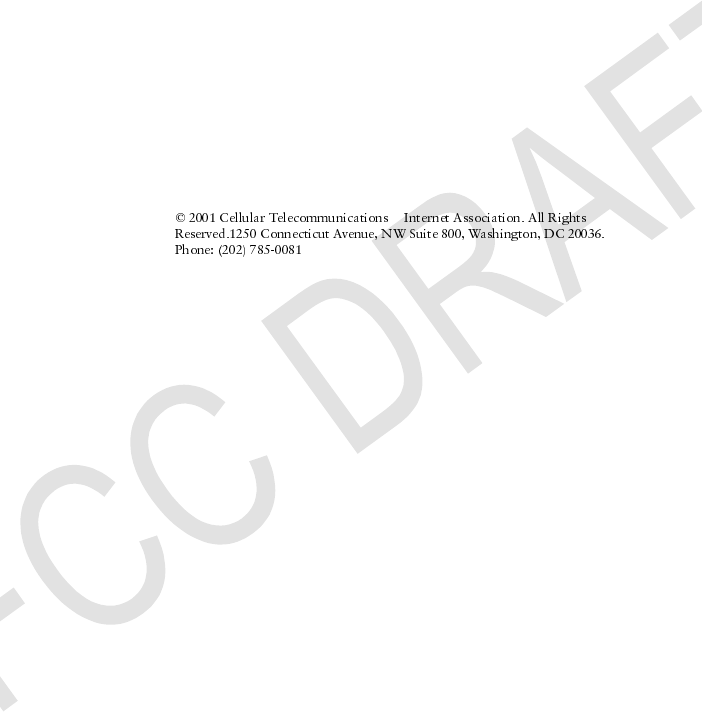
[ 113 ]
Appendix A Message from the CTIA
Appendix A Message from the
CTIA
(Cellular Telecommunications
& Internet Association)
to all users of mobile phones.
&
6820.ENv1_9310322.book Page 113 Wednesday, October 15, 2003 1:43 PM
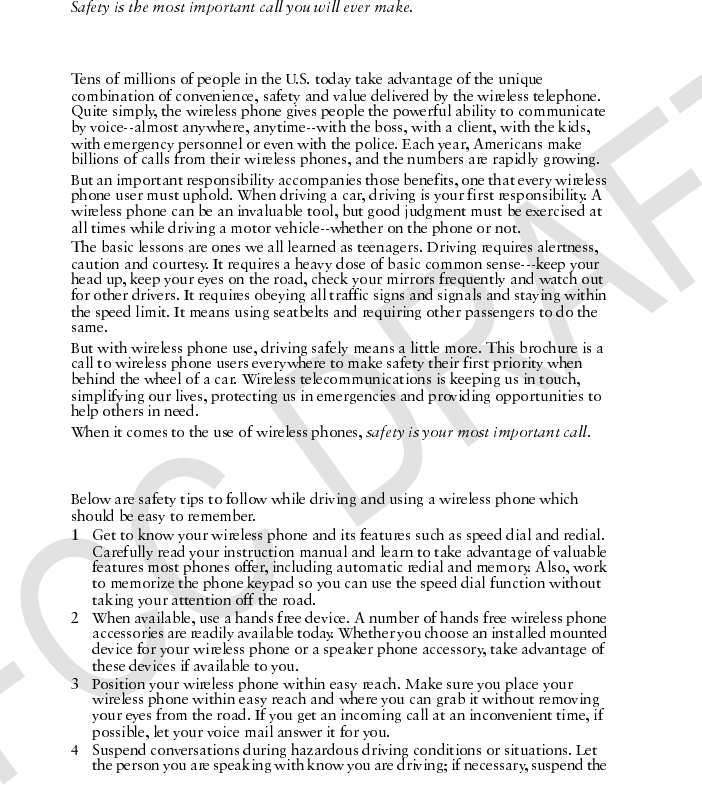
[ 114 ]
A Guide to Safe and Responsible Wireless Phone Use
Wireless Phone "Safety Tips"
6820.ENv1_9310322.book Page 114 Wednesday, October 15, 2003 1:43 PM
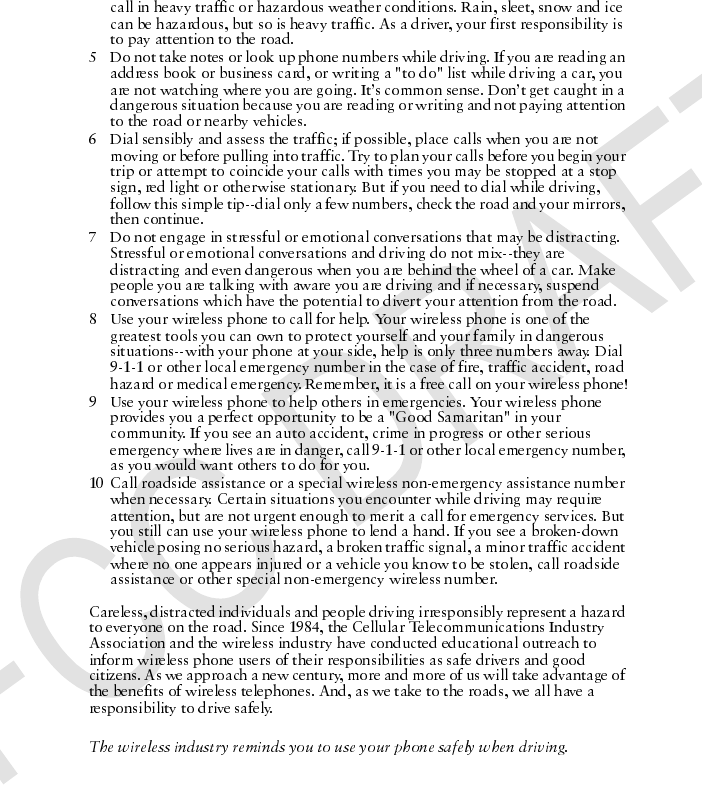
[ 115 ]
Appendix A Message from the CTIA
6820.ENv1_9310322.book Page 115 Wednesday, October 15, 2003 1:43 PM
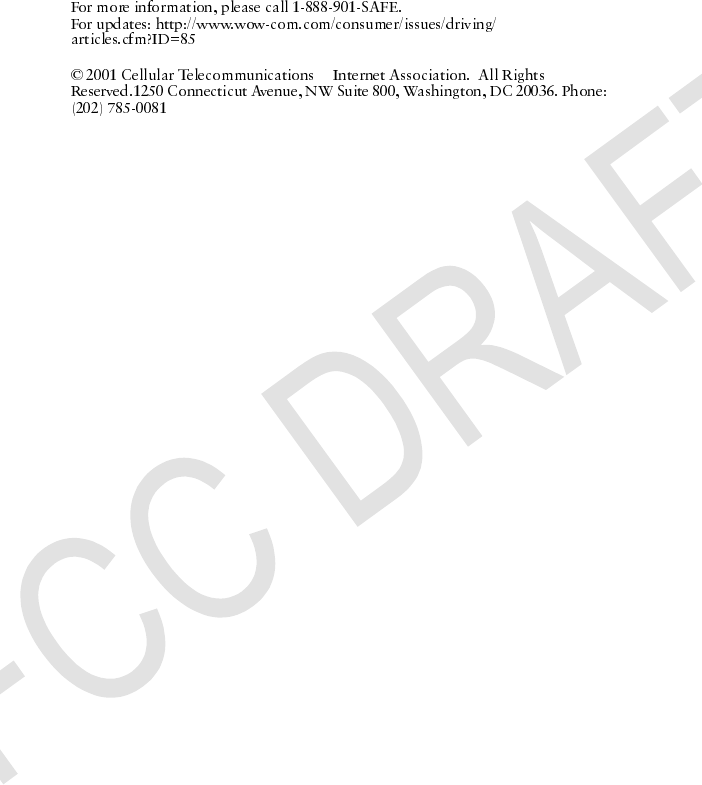
[ 116 ]
&
6820.ENv1_9310322.book Page 116 Wednesday, October 15, 2003 1:43 PM
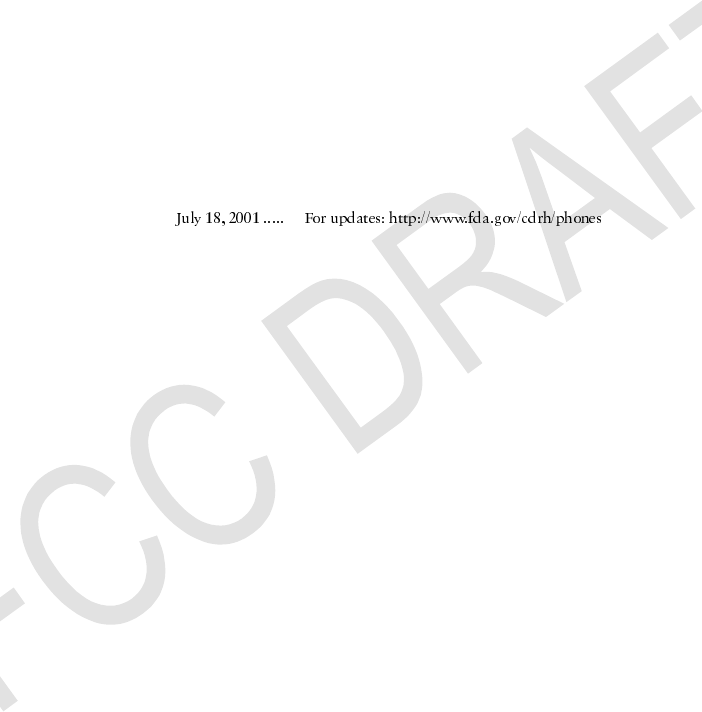
[ 117 ]
Appendix B Message from the FDA
Appendix B Message from the
FDA
(U.S. Food and Drug
Administration) to all users
of mobile phones.
6820.ENv1_9310322.book Page 117 Wednesday, October 15, 2003 1:43 PM
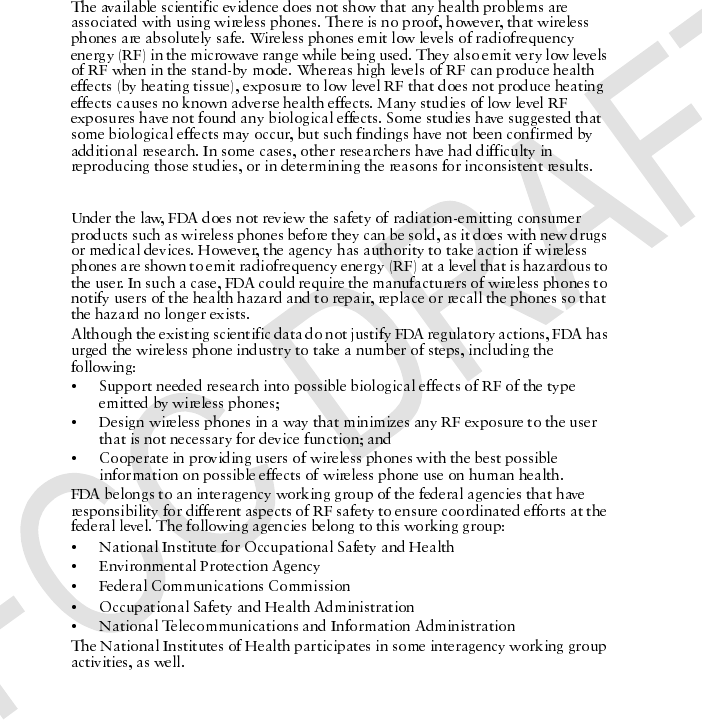
[ 118 ]
Consumer Update on Wireless Phones
U.S. Food and Drug Administration
1. Do wireless phones pose a health hazard?
2. What is FDA’s role concerning the safety of wireless phones?
6820.ENv1_9310322.book Page 118 Wednesday, October 15, 2003 1:43 PM
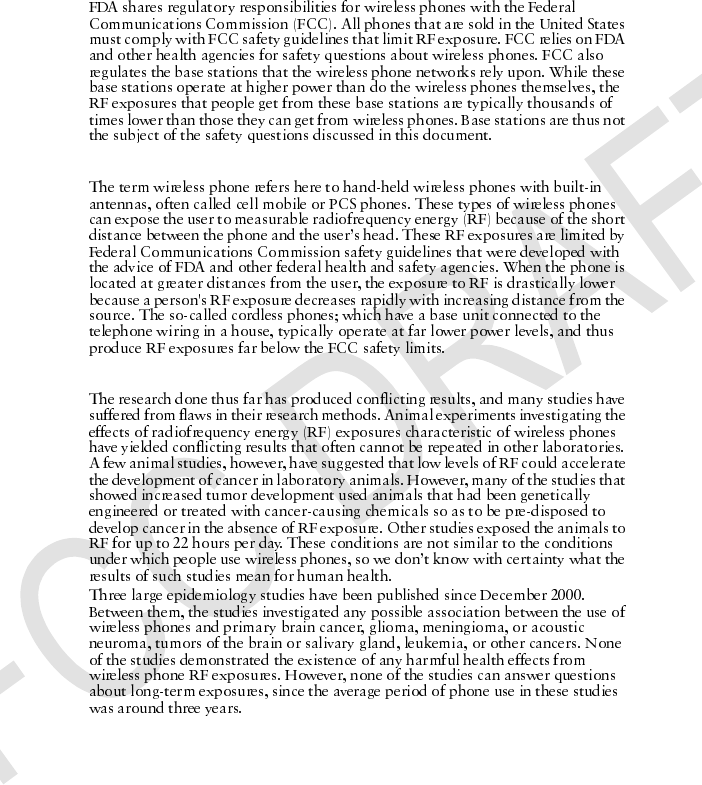
[ 119 ]
Appendix B Message from the FDA
3. What kinds of phones are the subject of this update?
4. What are the results of the research done already?
5.What research is needed to decide whether RF exposure from wireless
phones poses a health risk?
6820.ENv1_9310322.book Page 119 Wednesday, October 15, 2003 1:43 PM
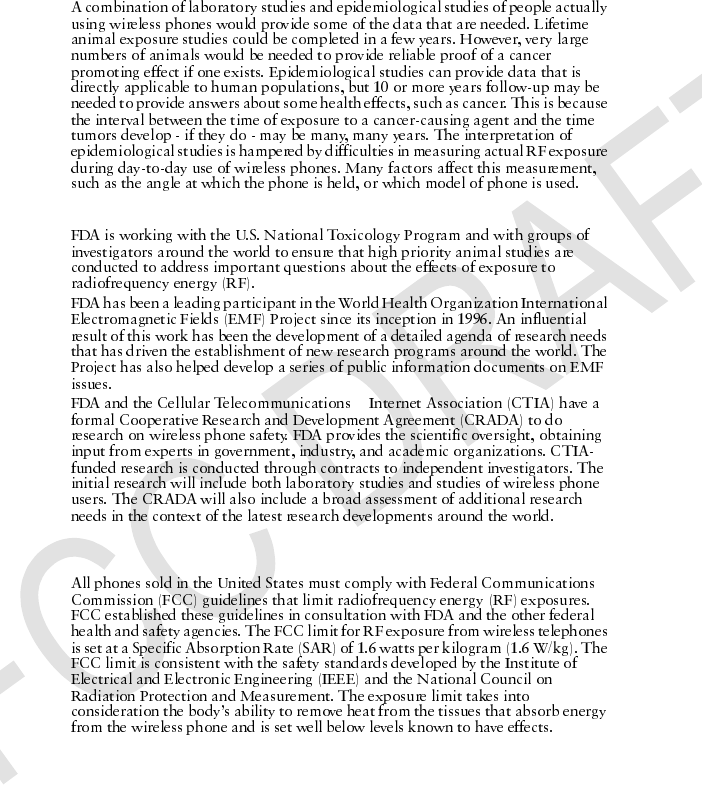
[ 120 ]
6. What is FDA doing to find out more about the possible health effects
of wireless phone RF?
&
7. How can I find out how much radiofrequency energy exposure I can
get by using my wireless phone?
6820.ENv1_9310322.book Page 120 Wednesday, October 15, 2003 1:43 PM
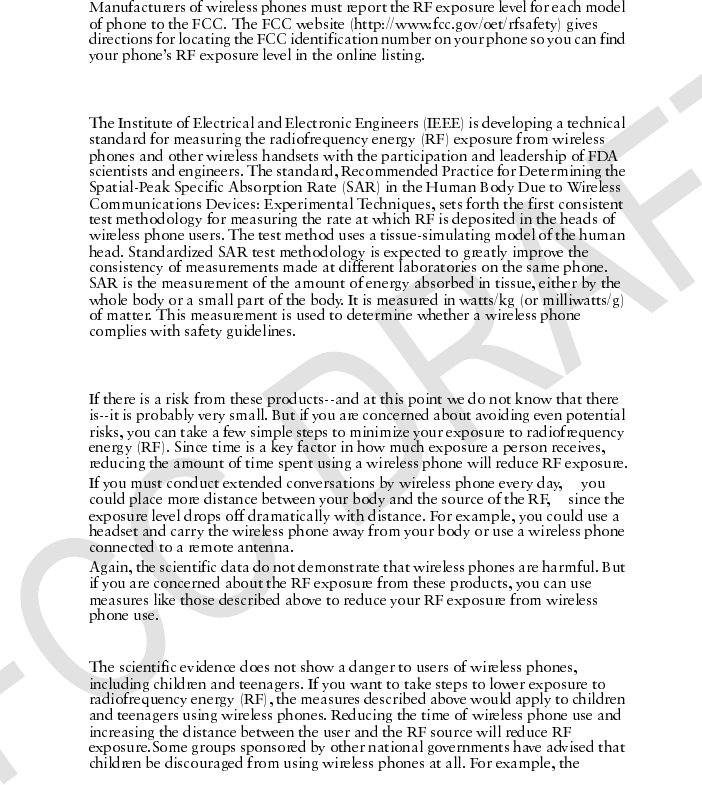
[ 121 ]
Appendix B Message from the FDA
8. What has FDA done to measure the radiofrequency energy coming
from wireless phones?
9. What steps can I take to reduce my exposure to radiofrequency
energy from my wireless phone?
10. What about children using wireless phones?
6820.ENv1_9310322.book Page 121 Wednesday, October 15, 2003 1:43 PM
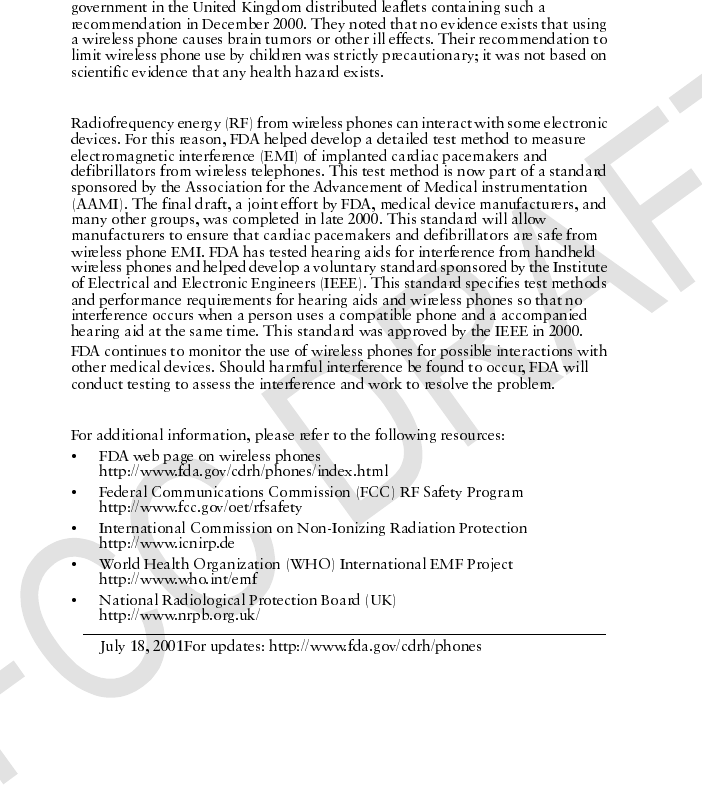
[ 122 ]
11. What about wireless phone interference with medical equipment?
12. Where can I find additional information?
6820.ENv1_9310322.book Page 122 Wednesday, October 15, 2003 1:43 PM

124 Copyright © Nokia 2003
6820.ENv1_9310322.book Page 124 Wednesday, October 15, 2003 1:43 PM

Para obtener un manual del usuario en español favor de llamar o enviar
un fax al teléfono 1-888-NOKIA-2U, fax 813-249-9619.
6820.ENv1_9310322.book Page 125 Wednesday, October 15, 2003 1:43 PM

Copyright © Nokia 2003
6820.ENv1_9310322.book Page 126 Wednesday, October 15, 2003 1:43 PM
